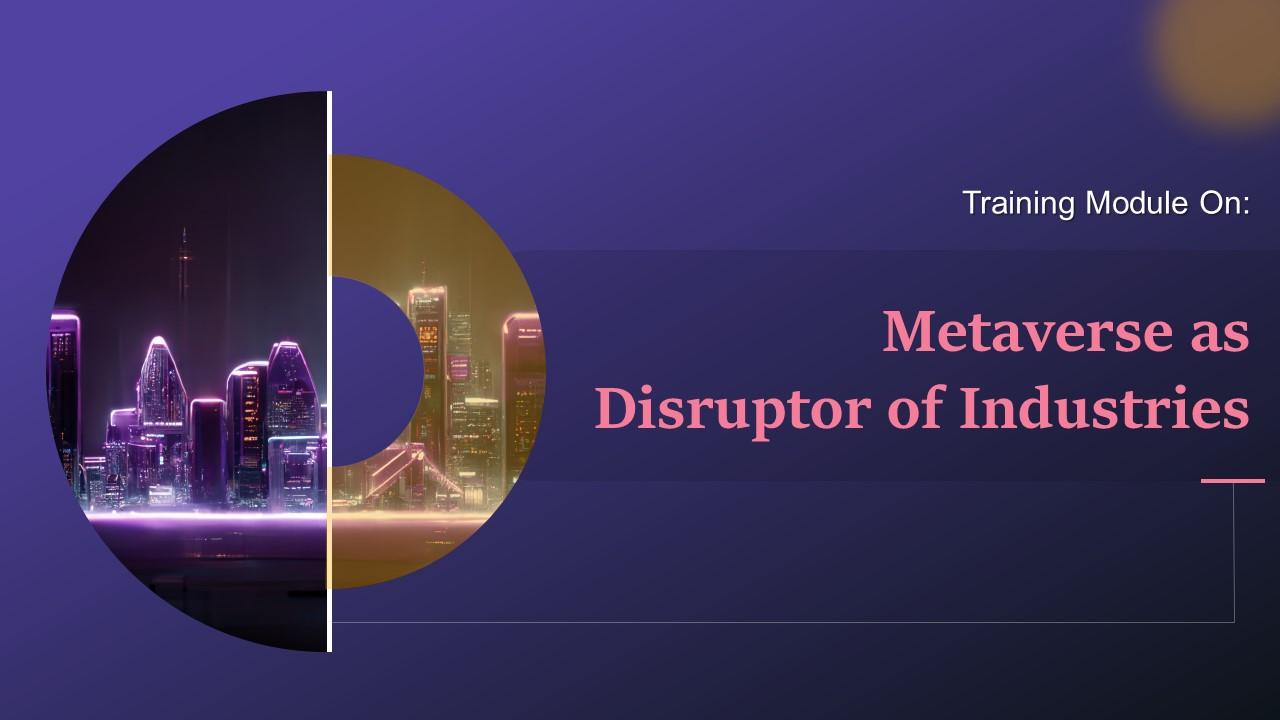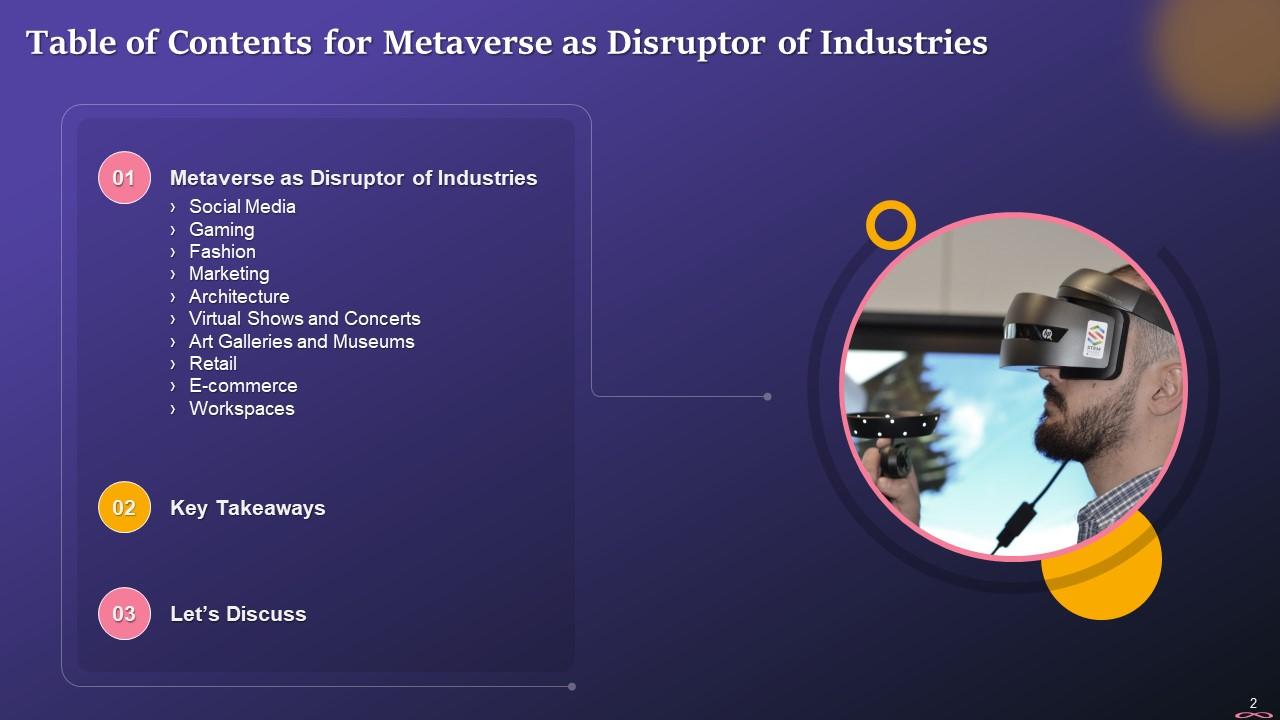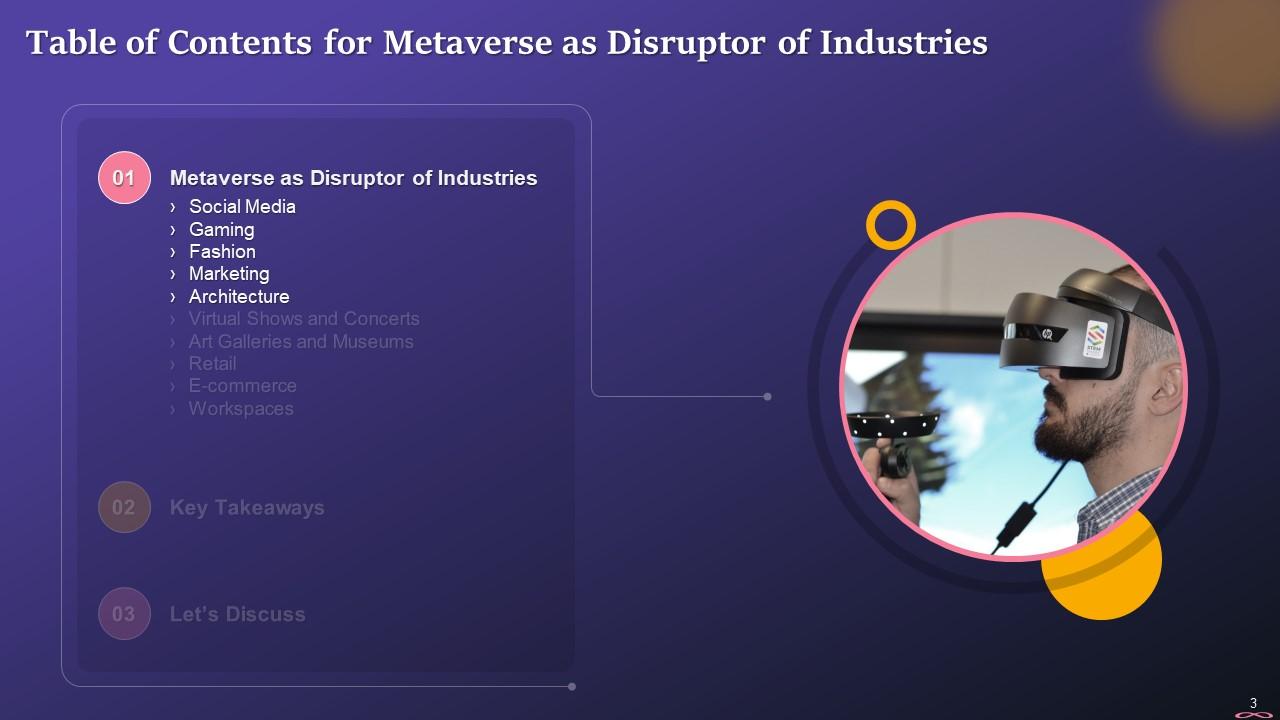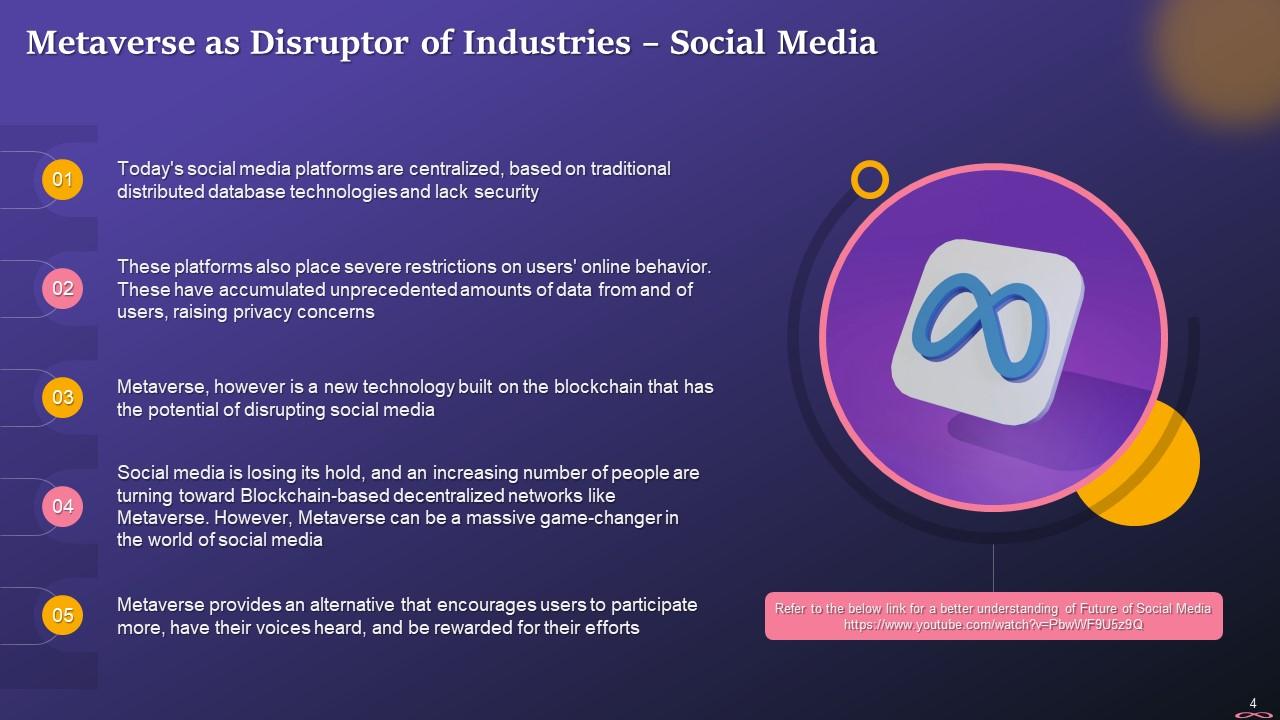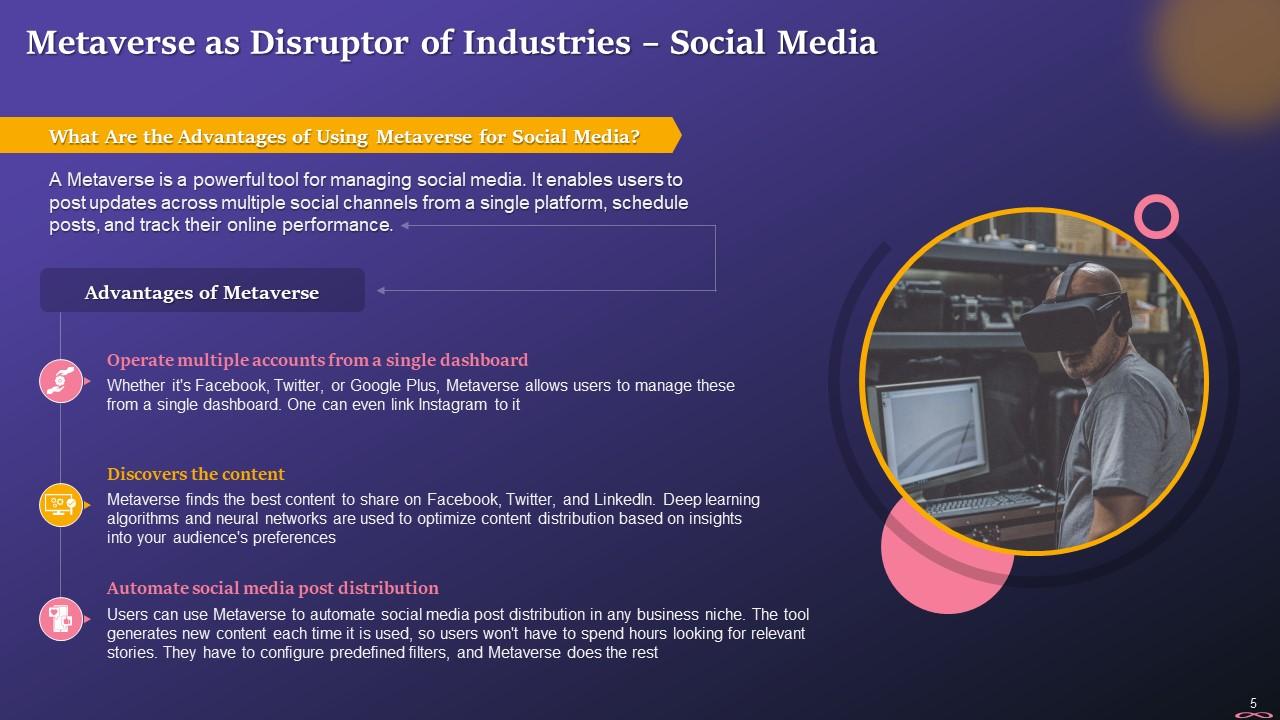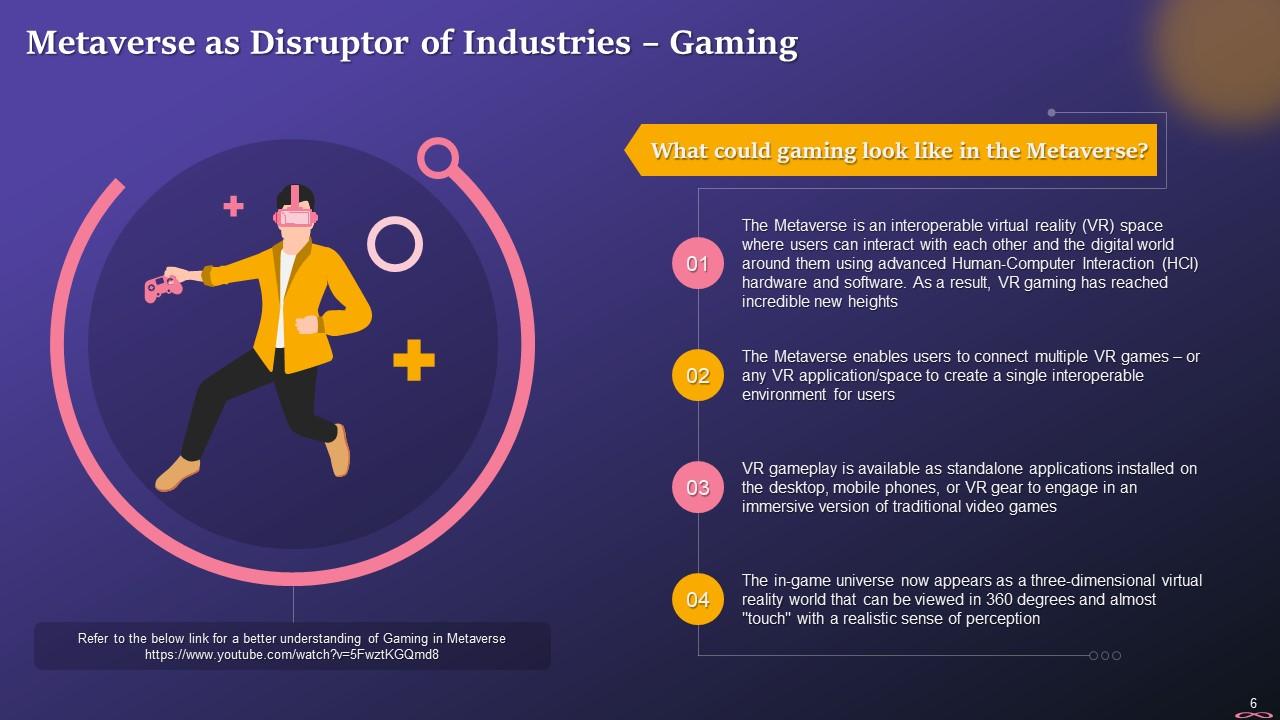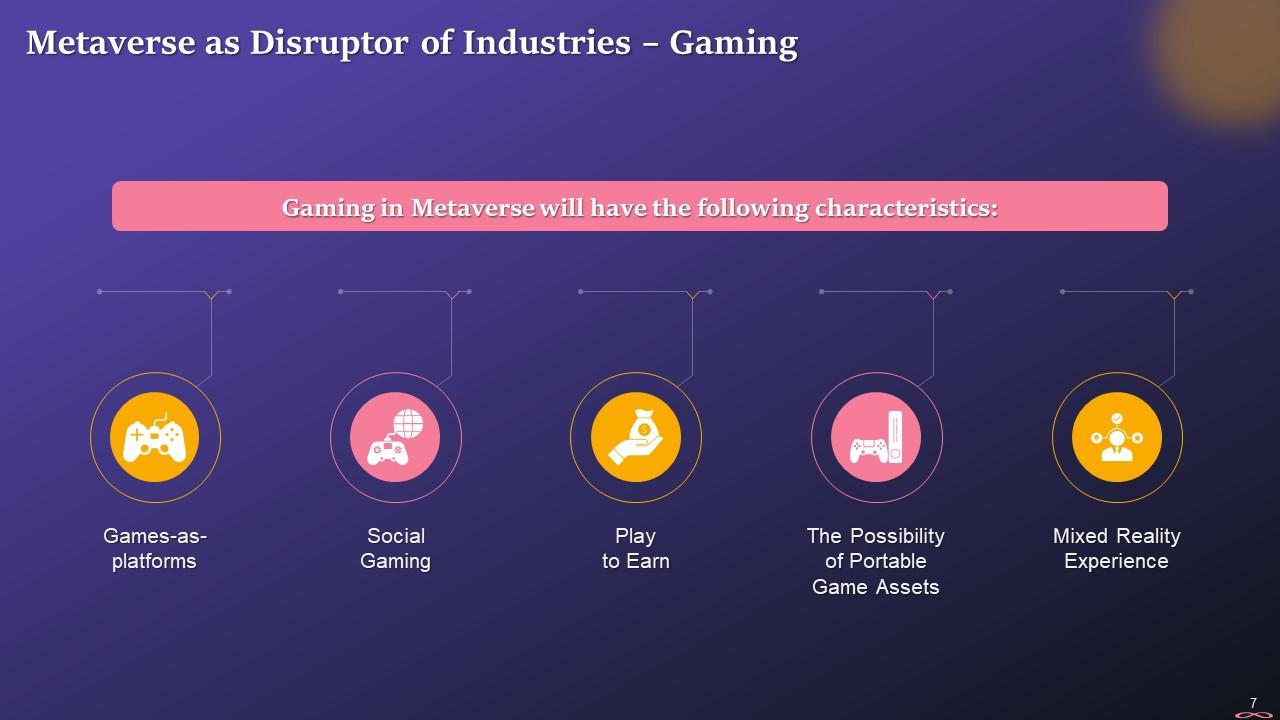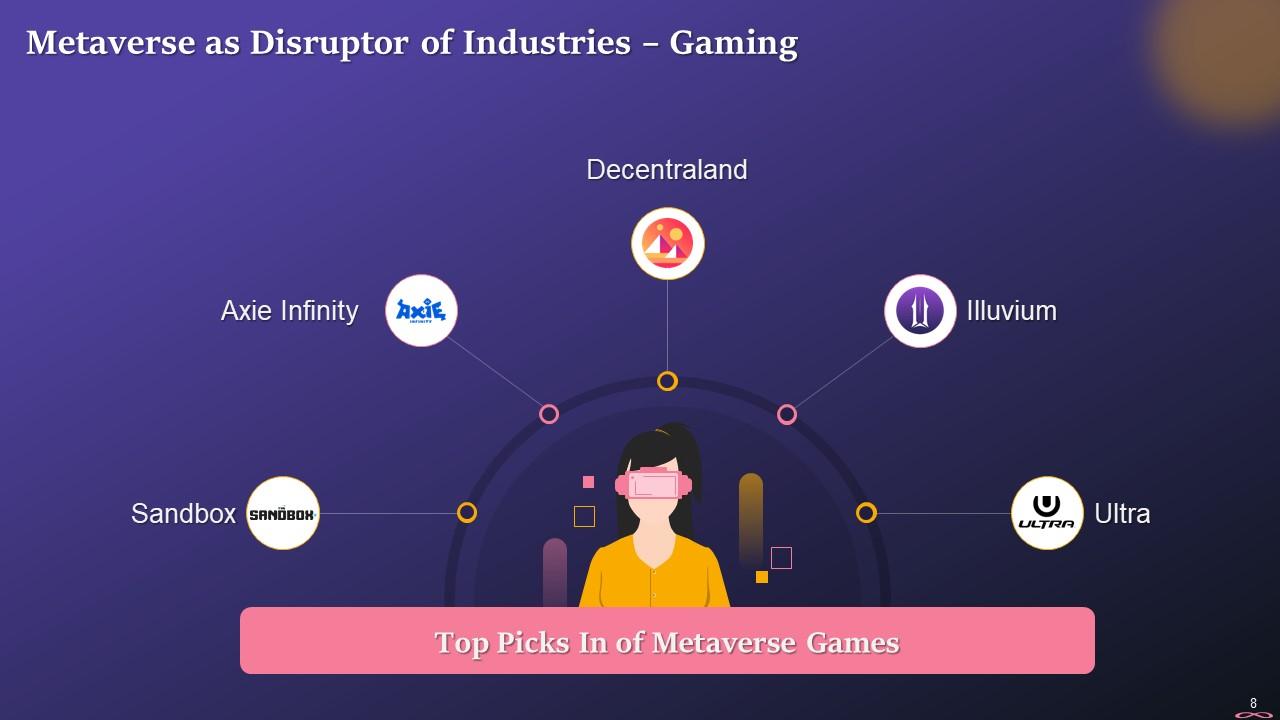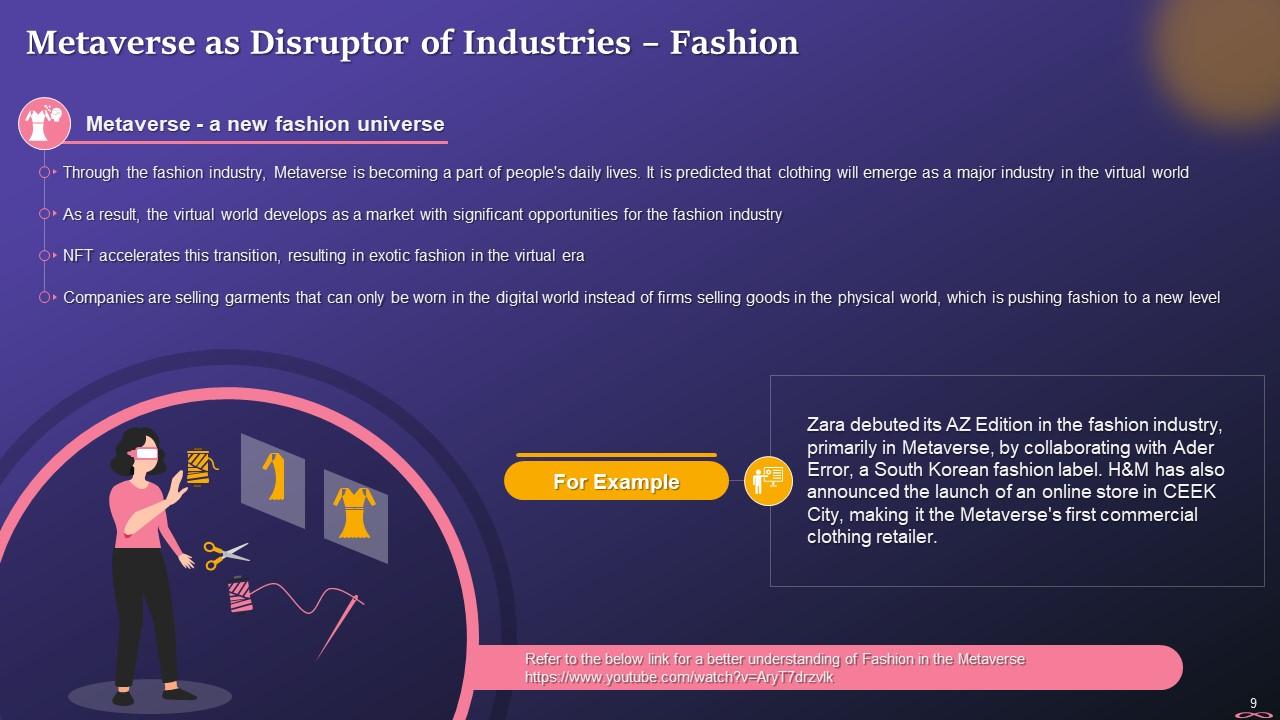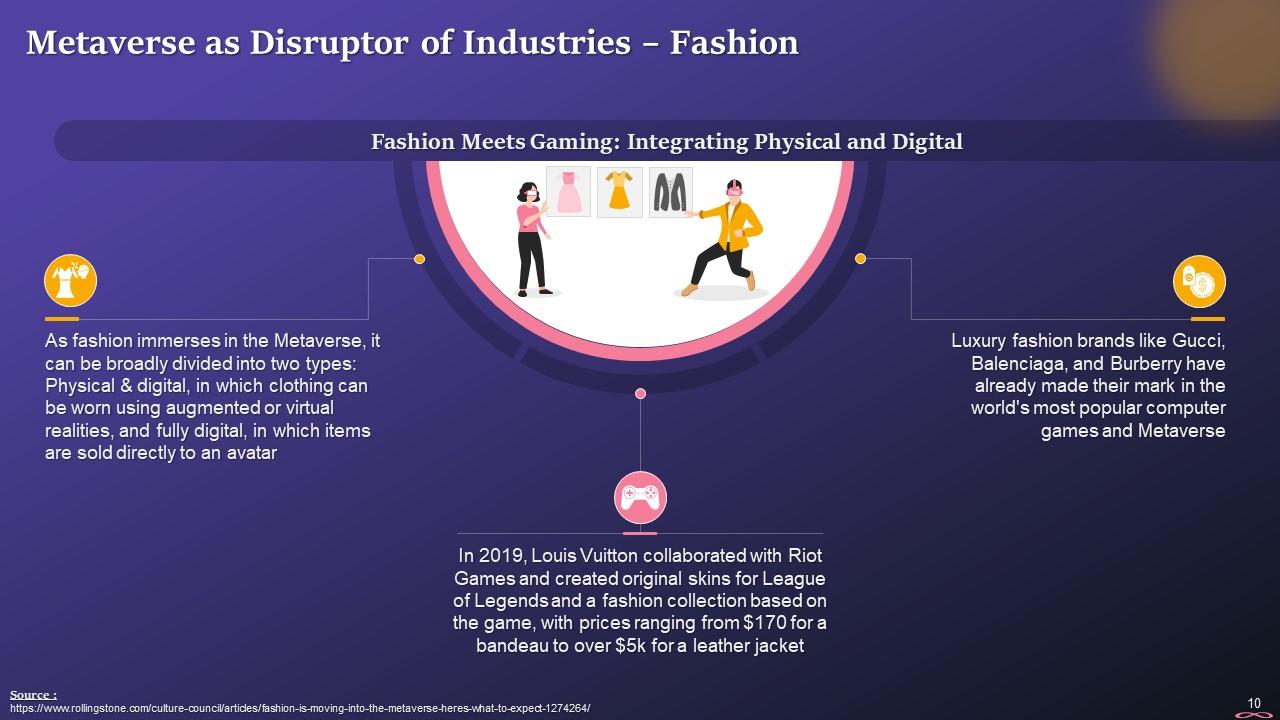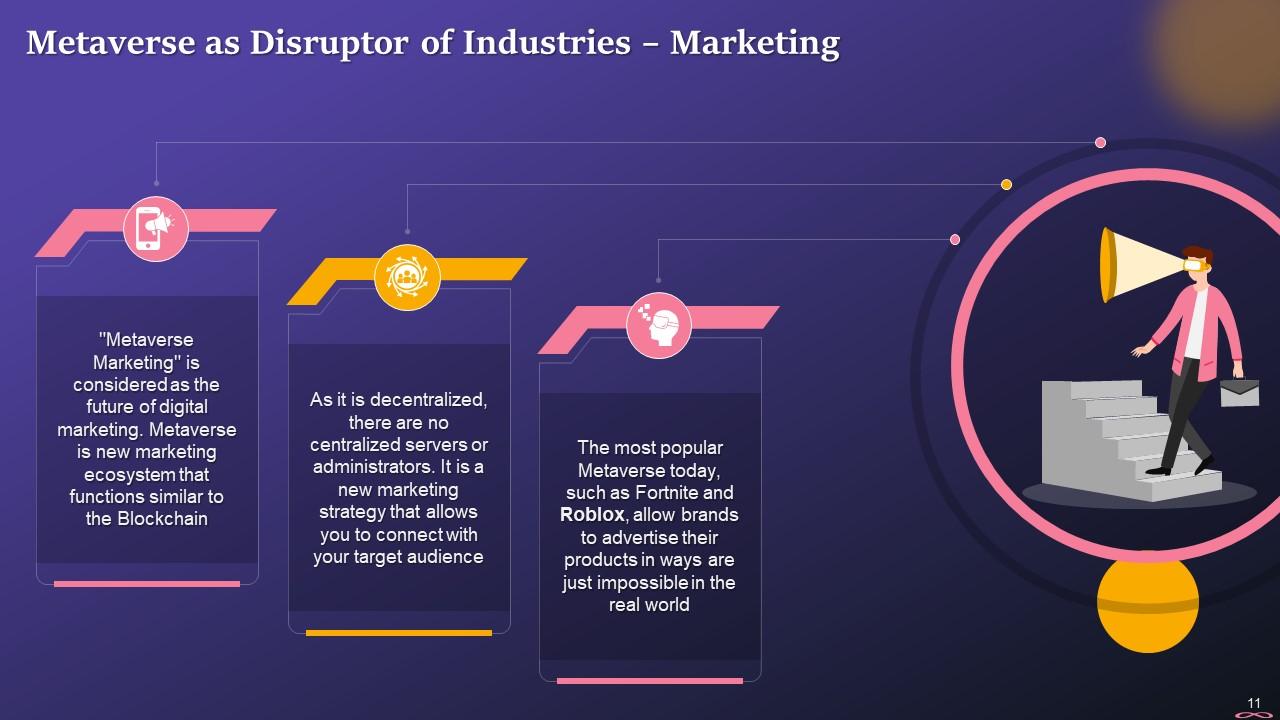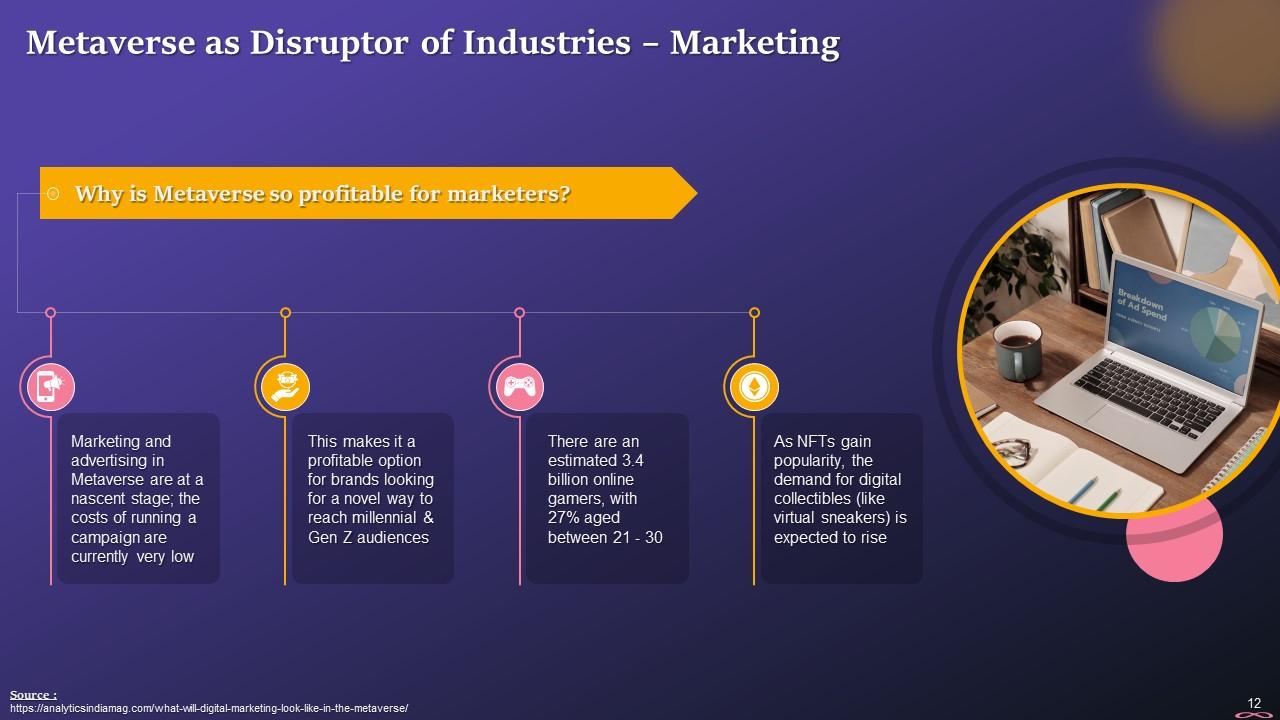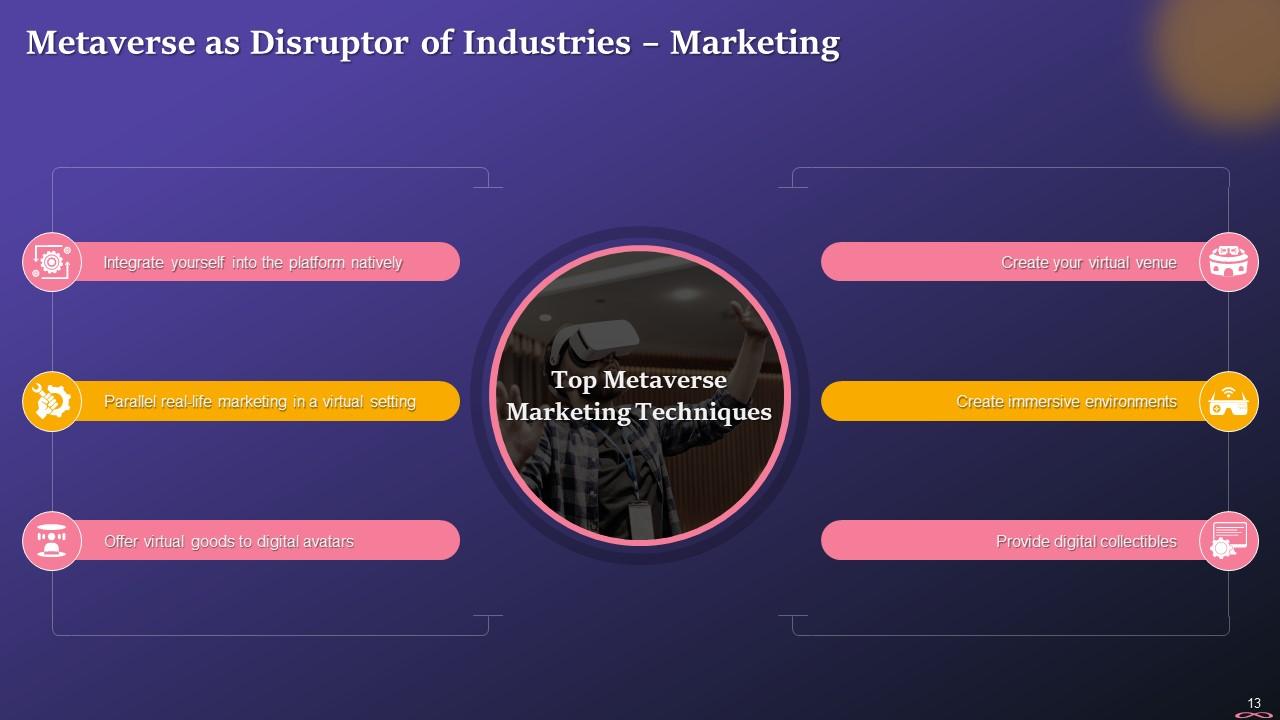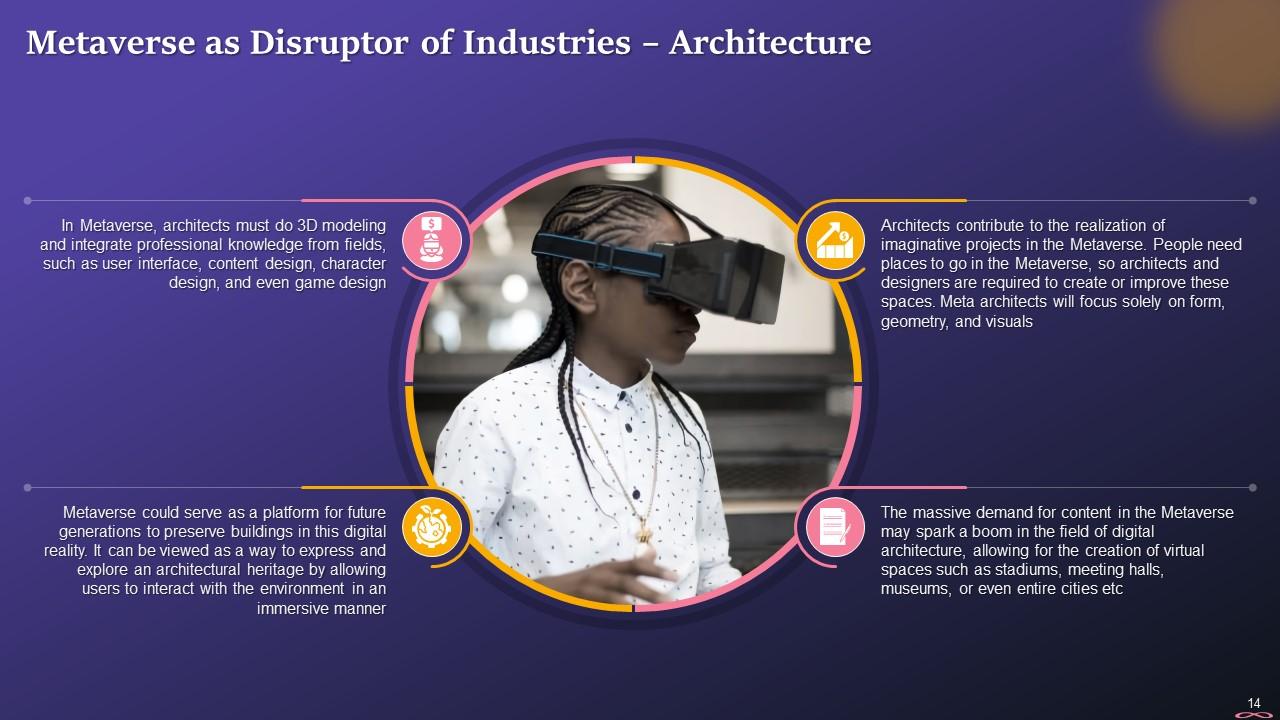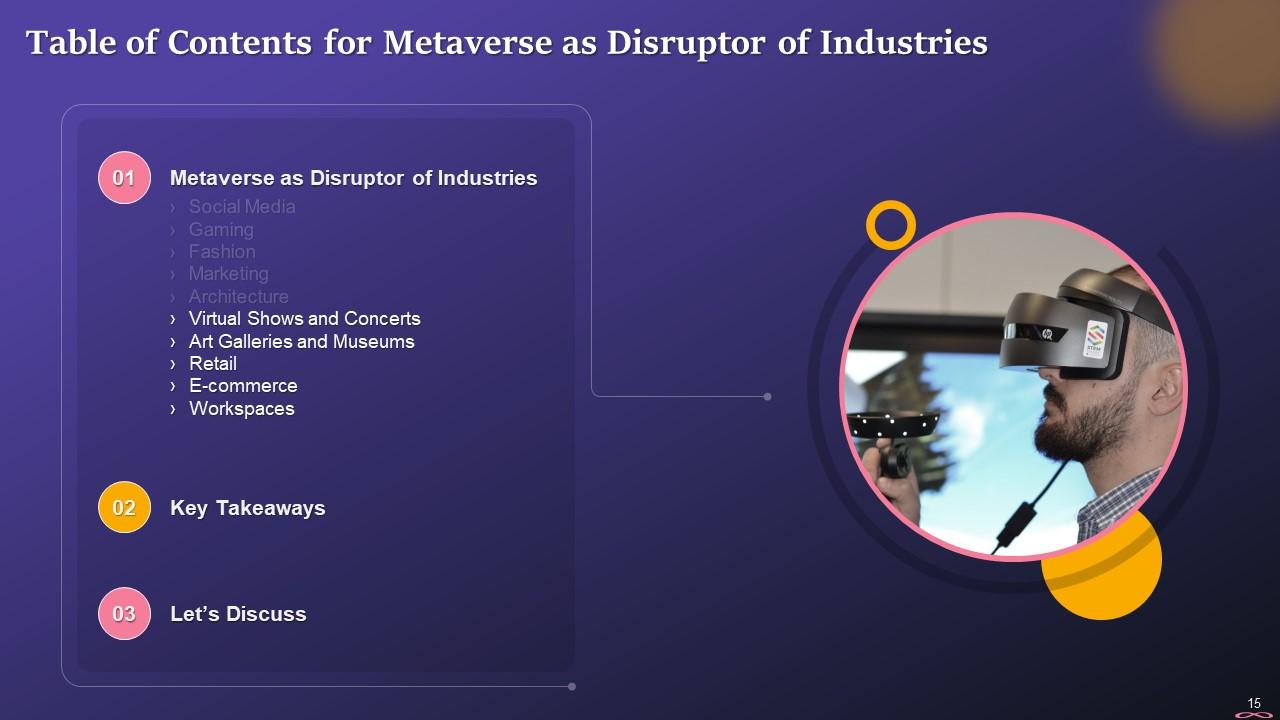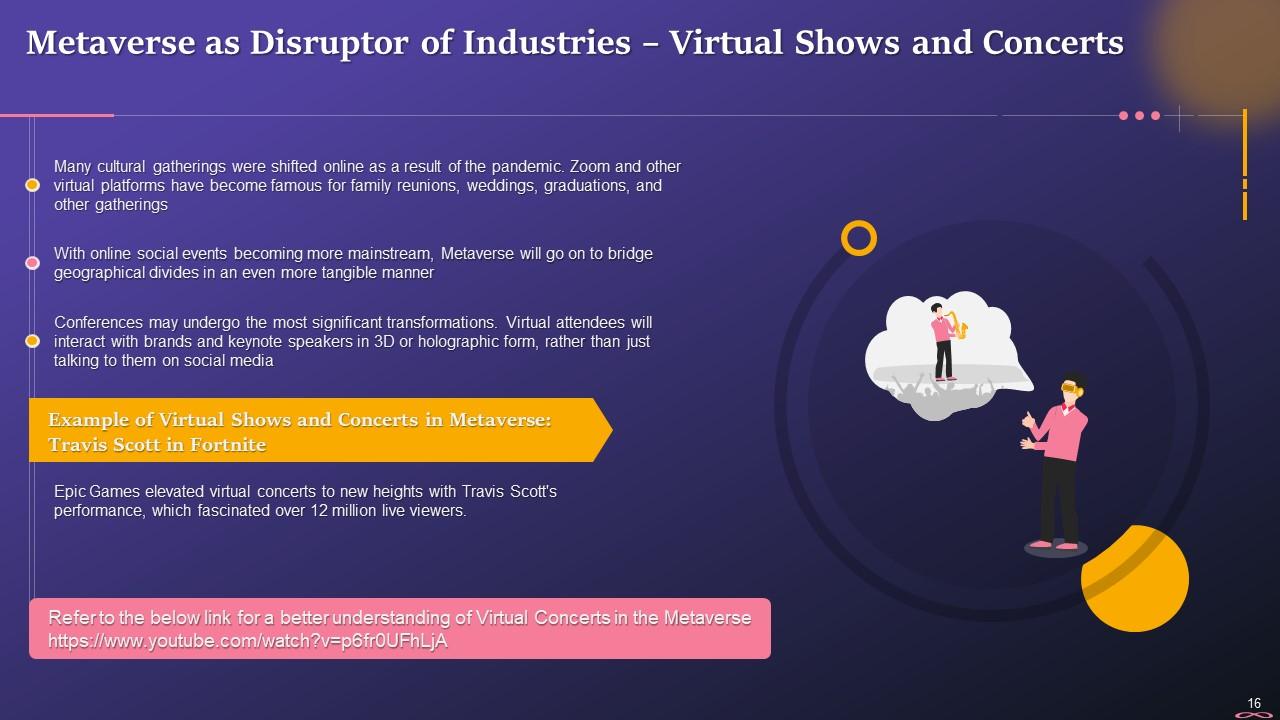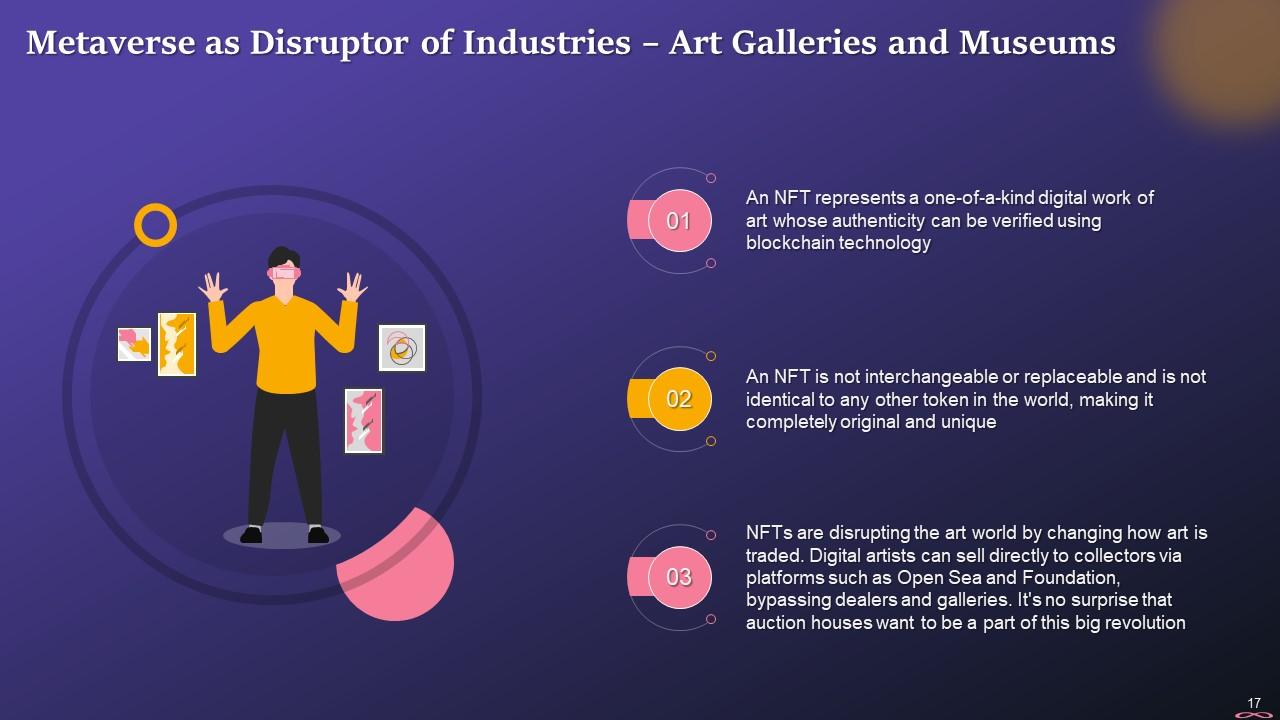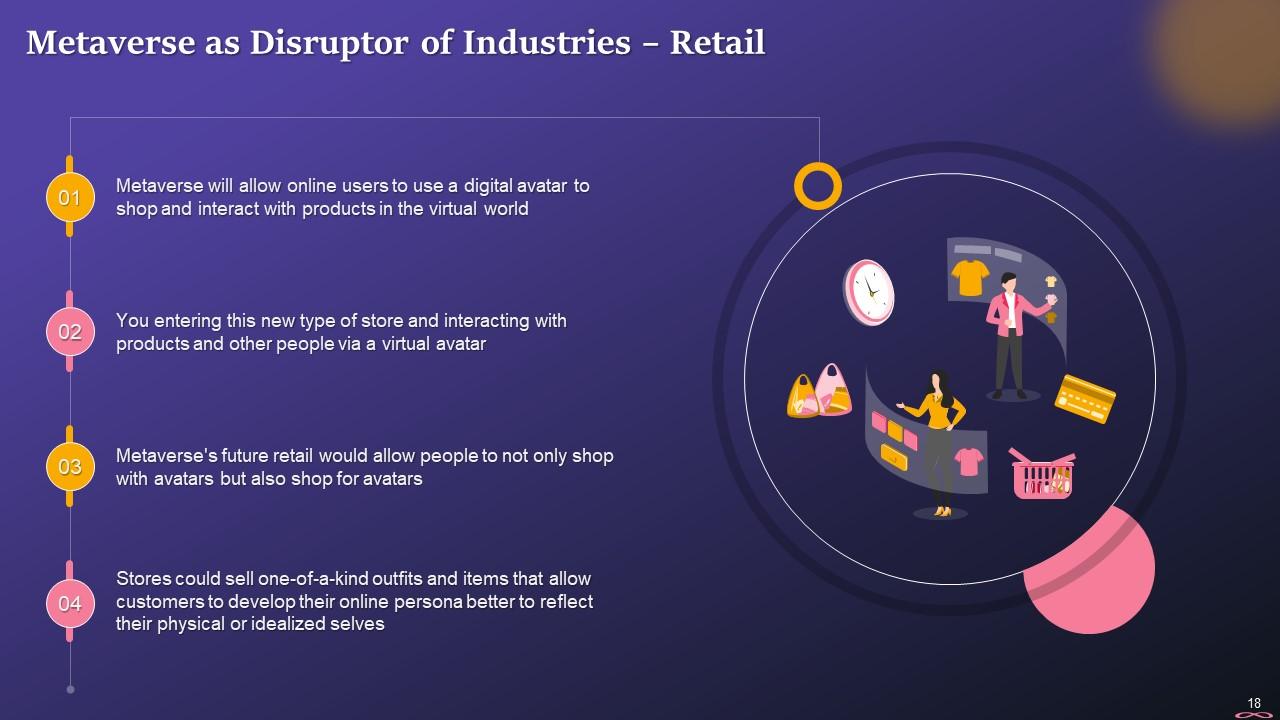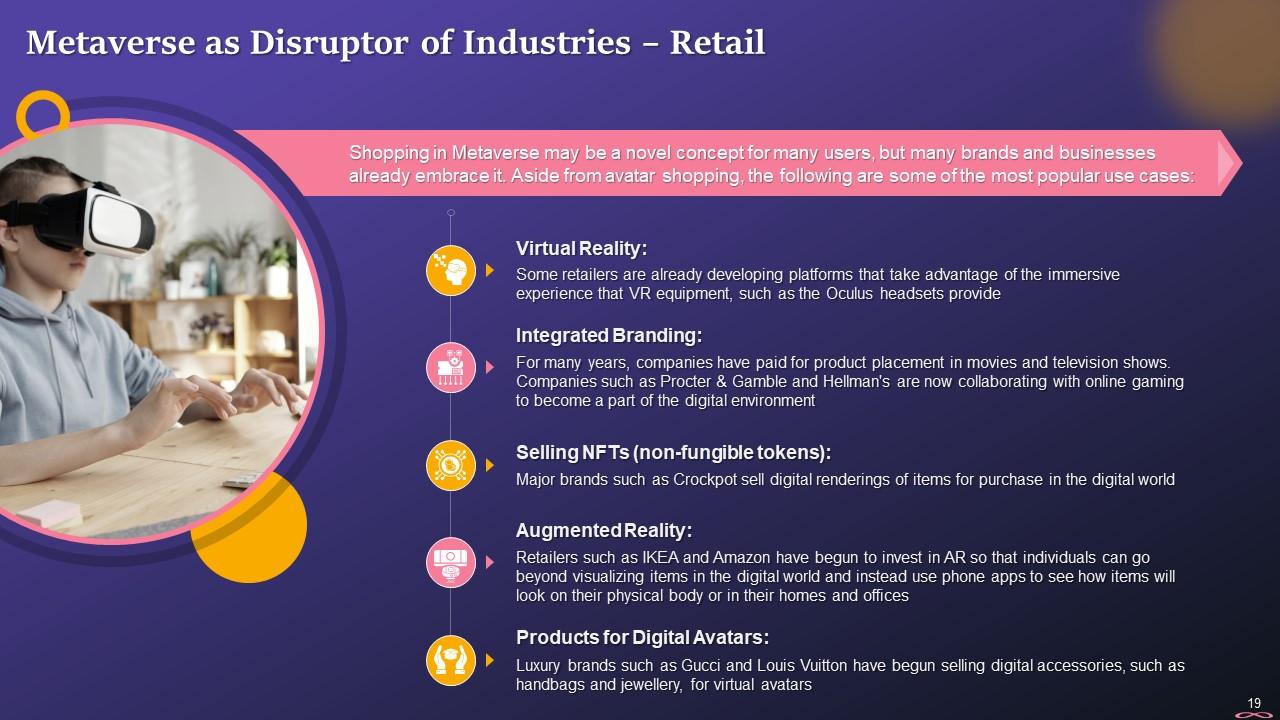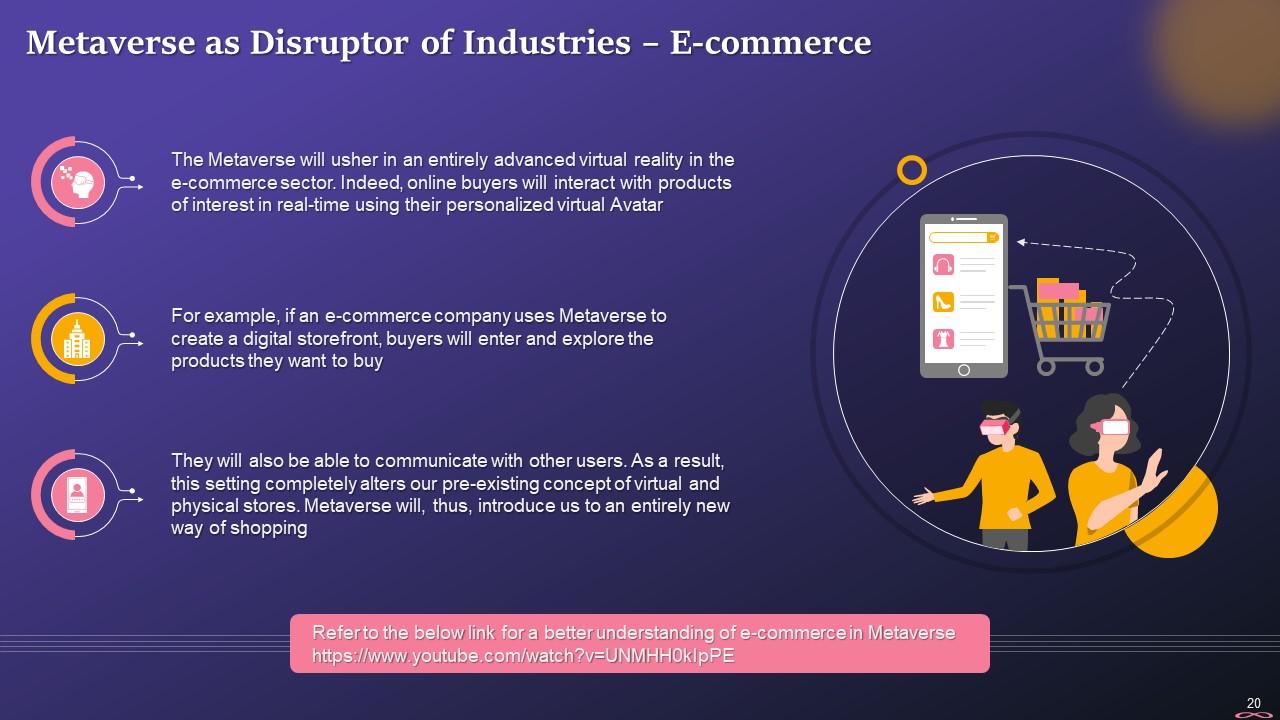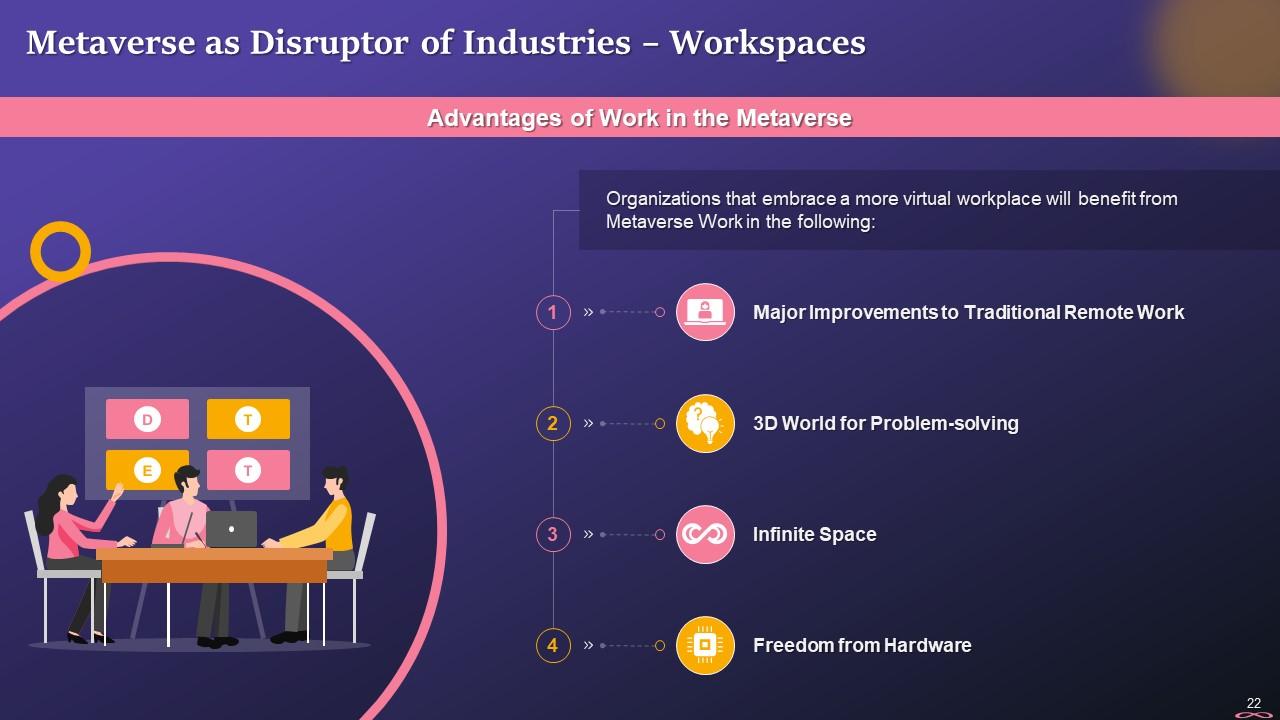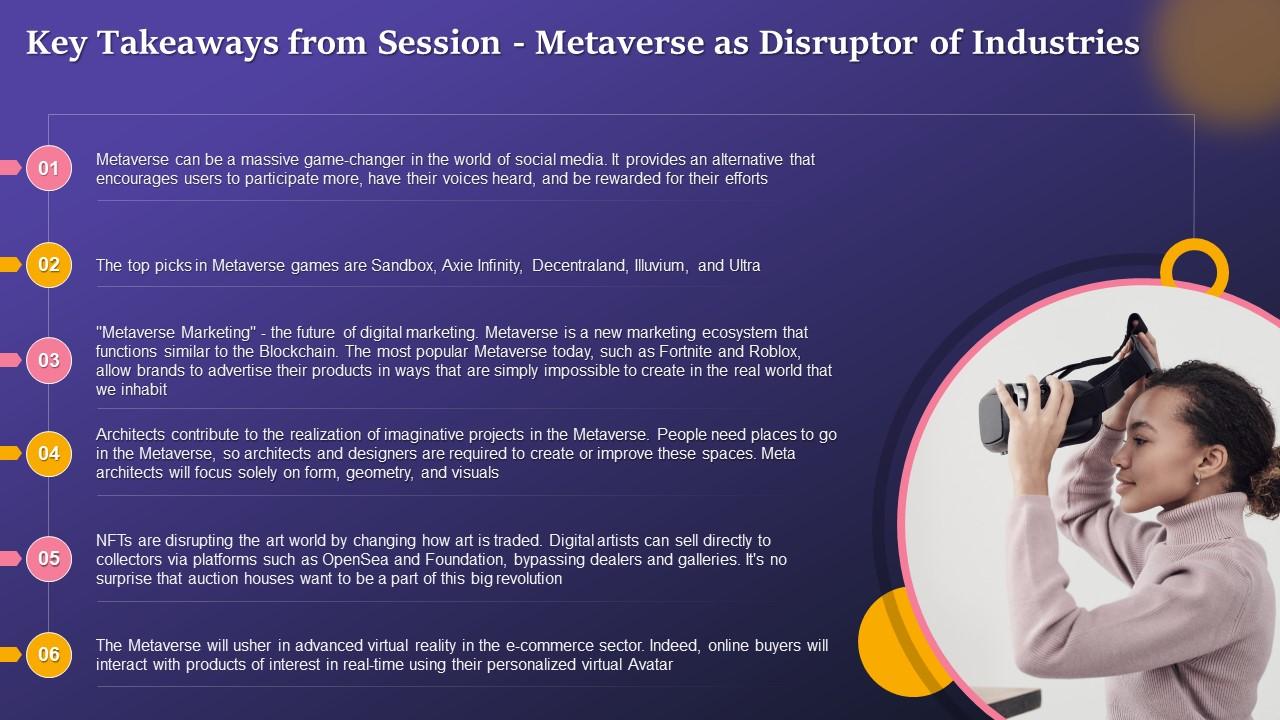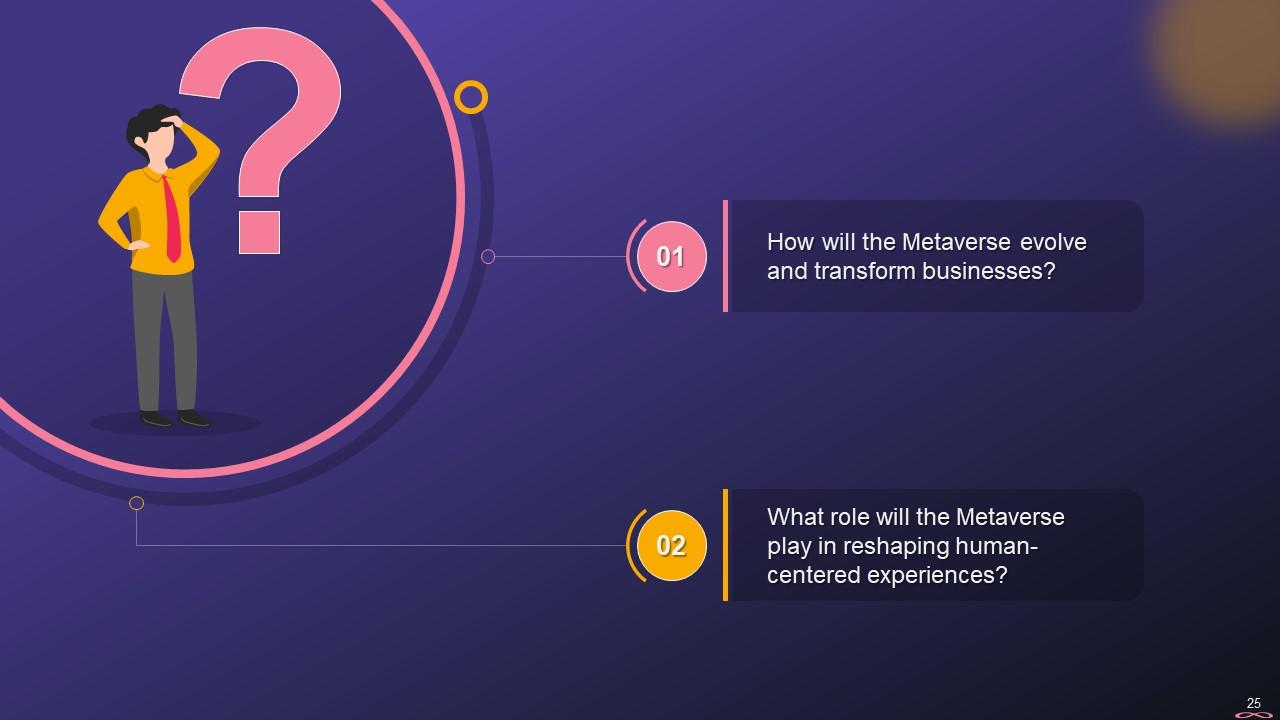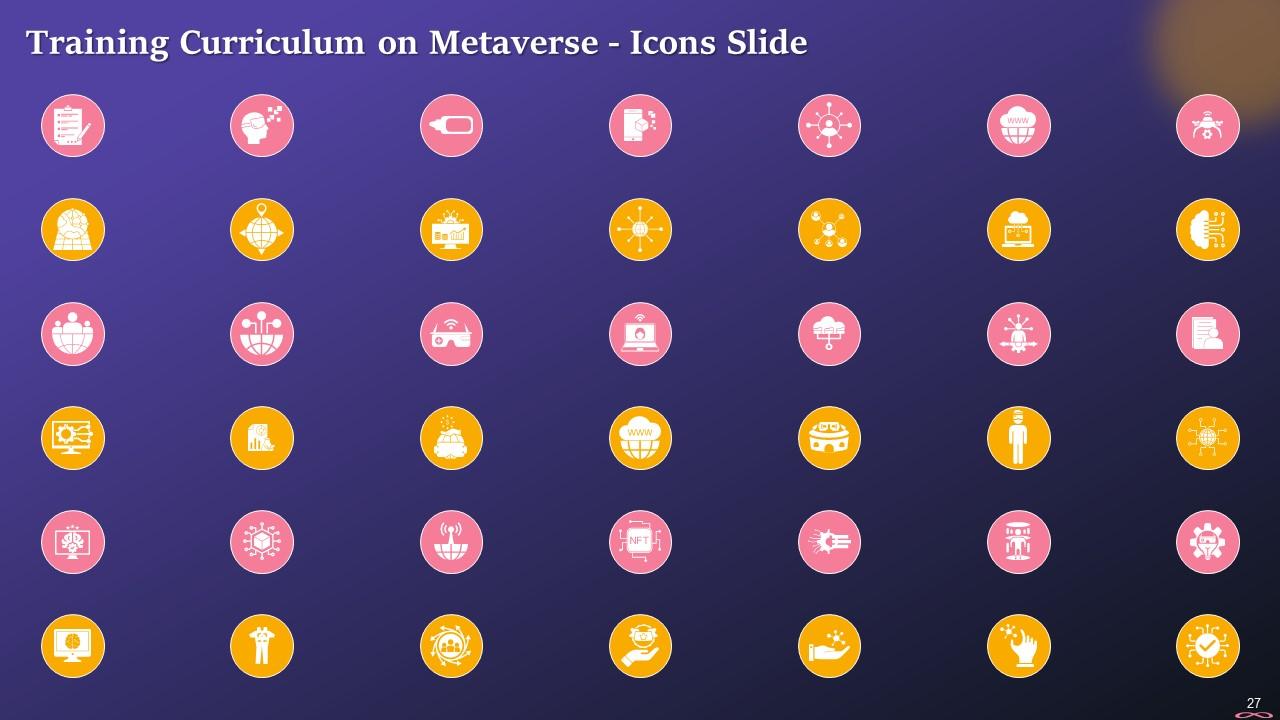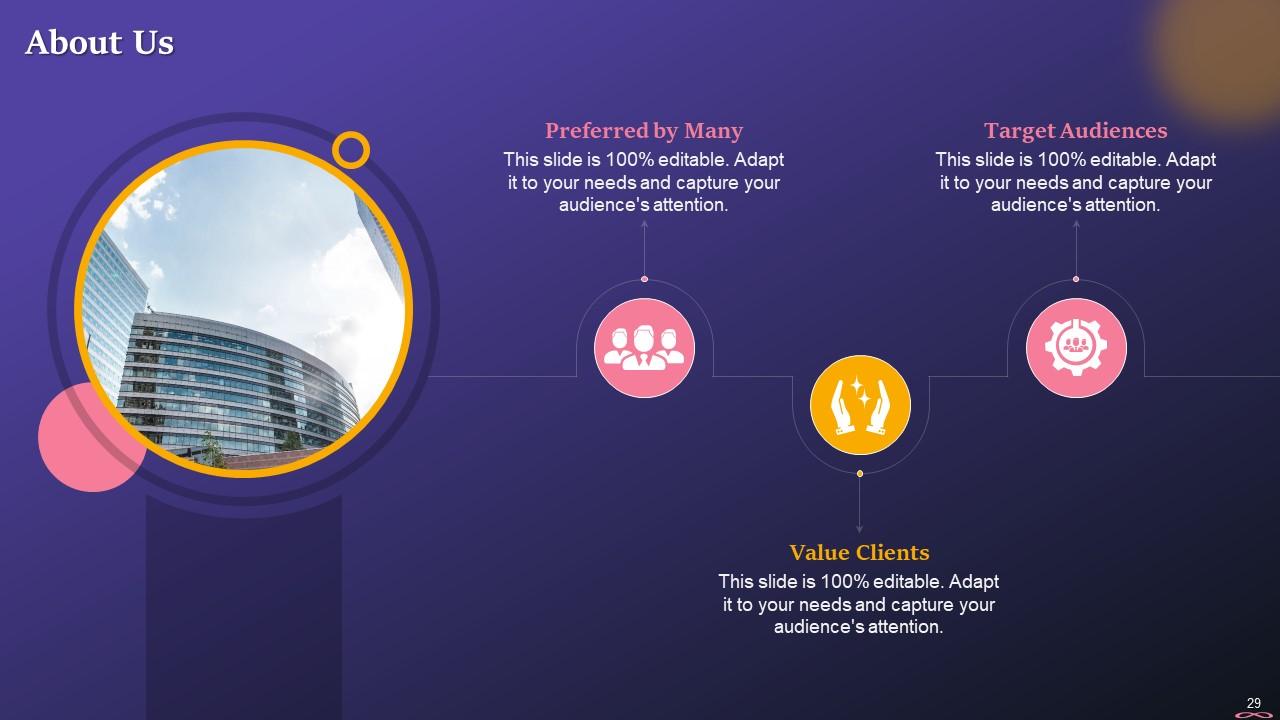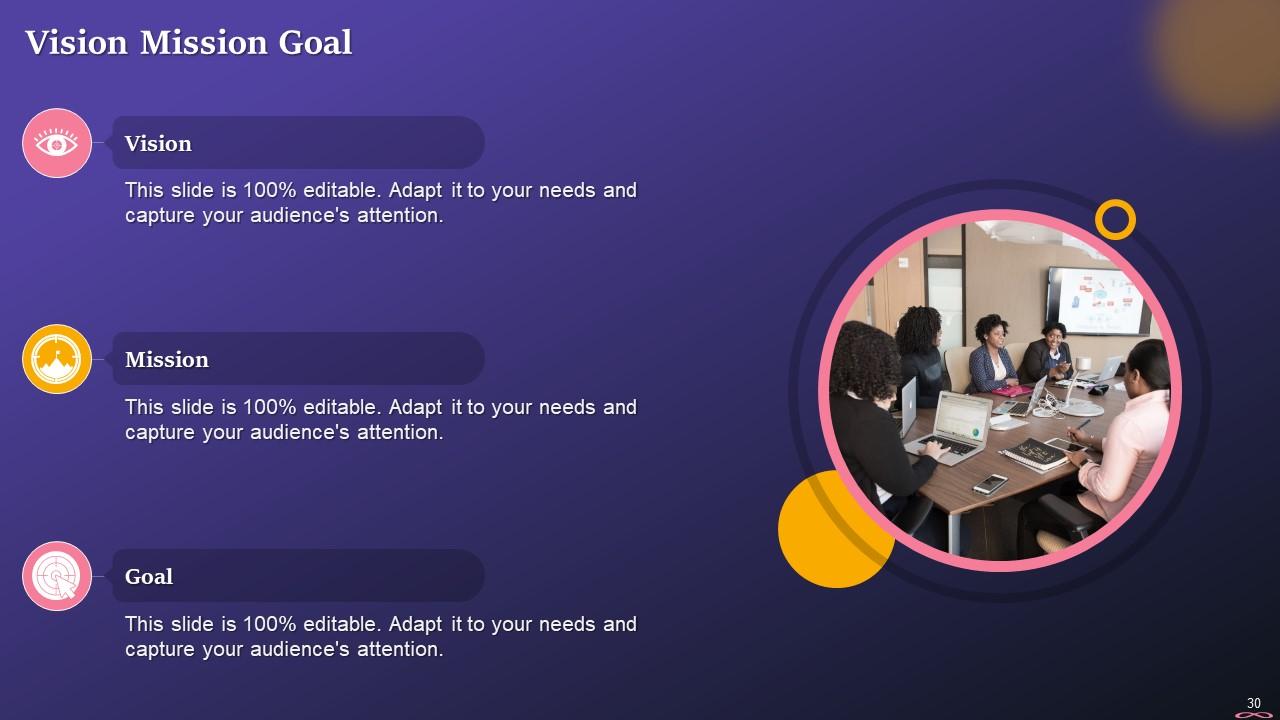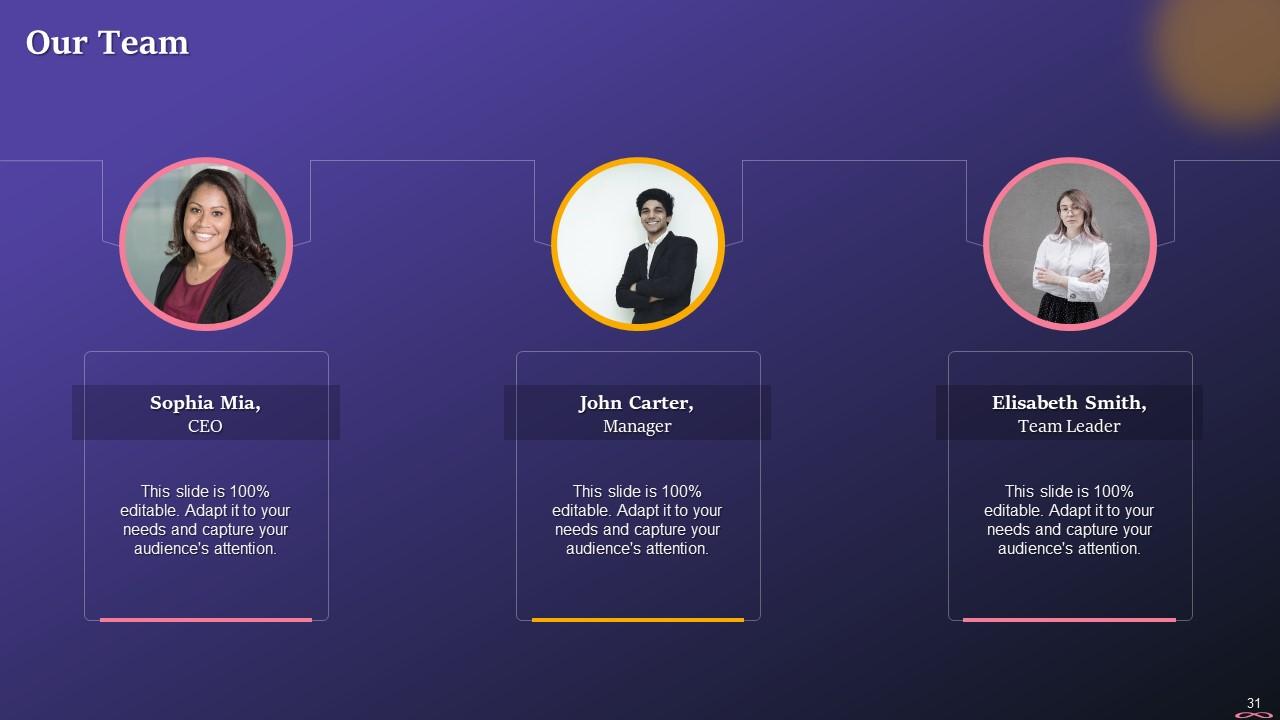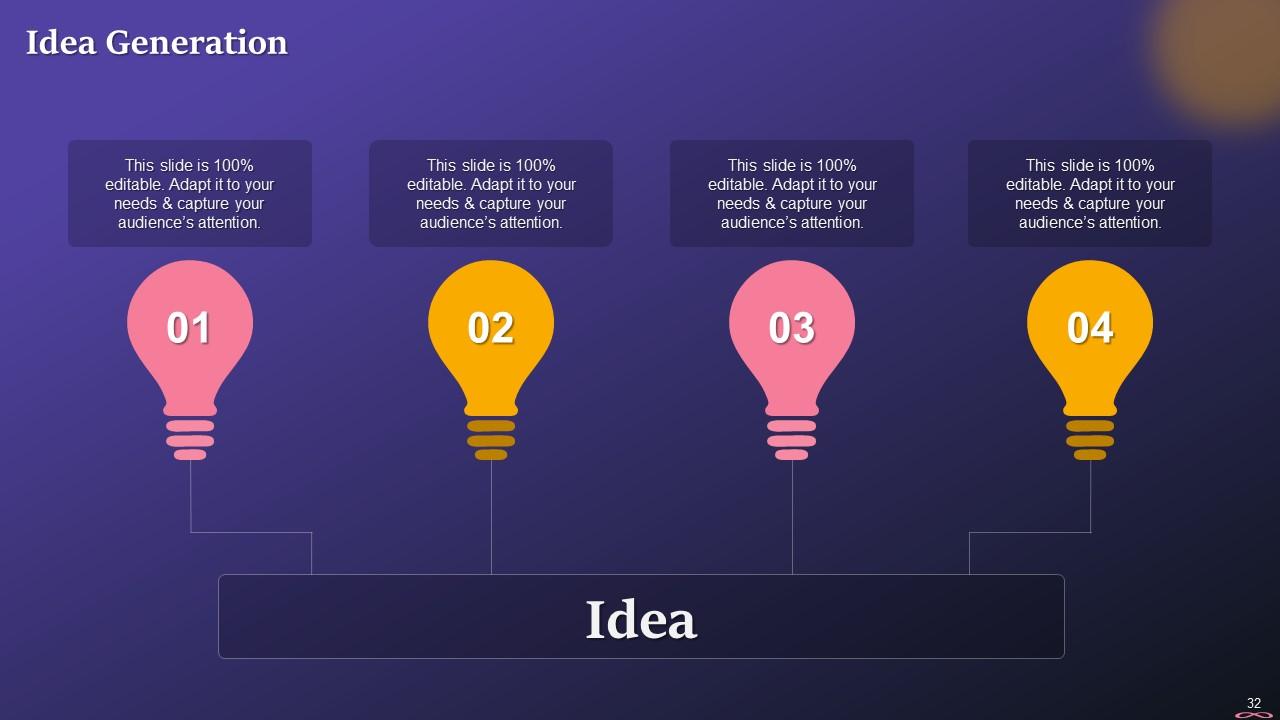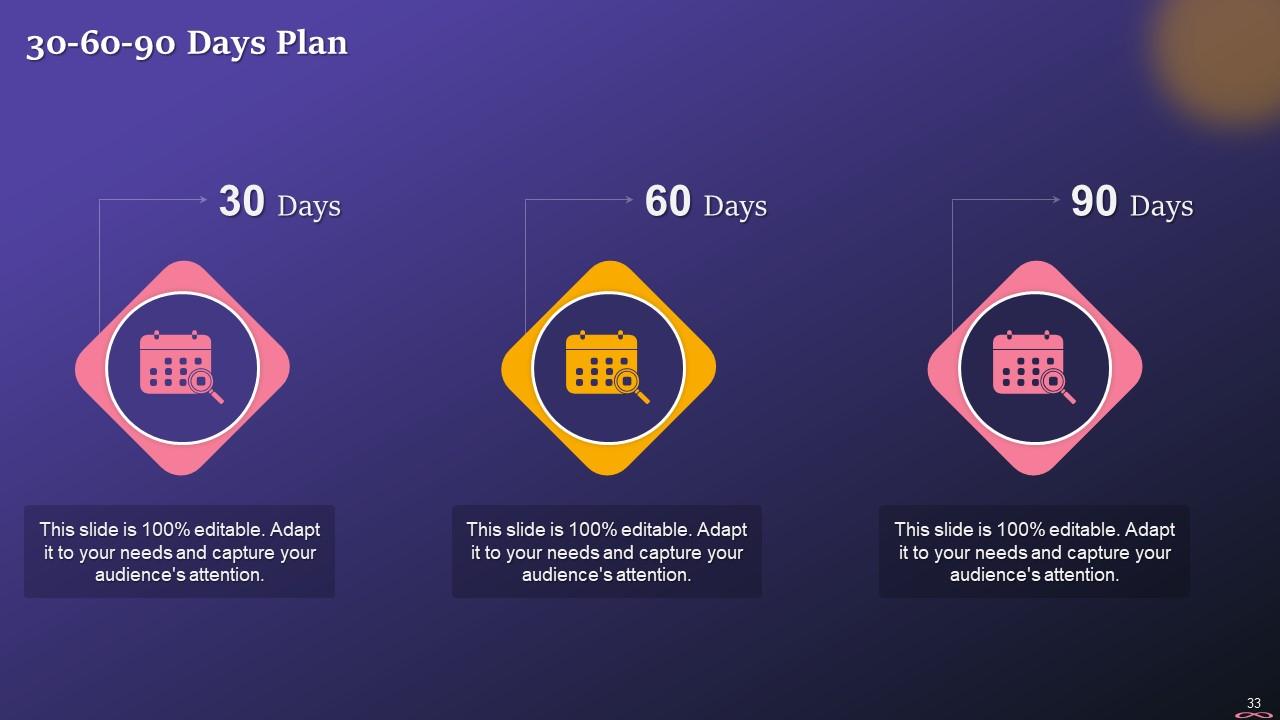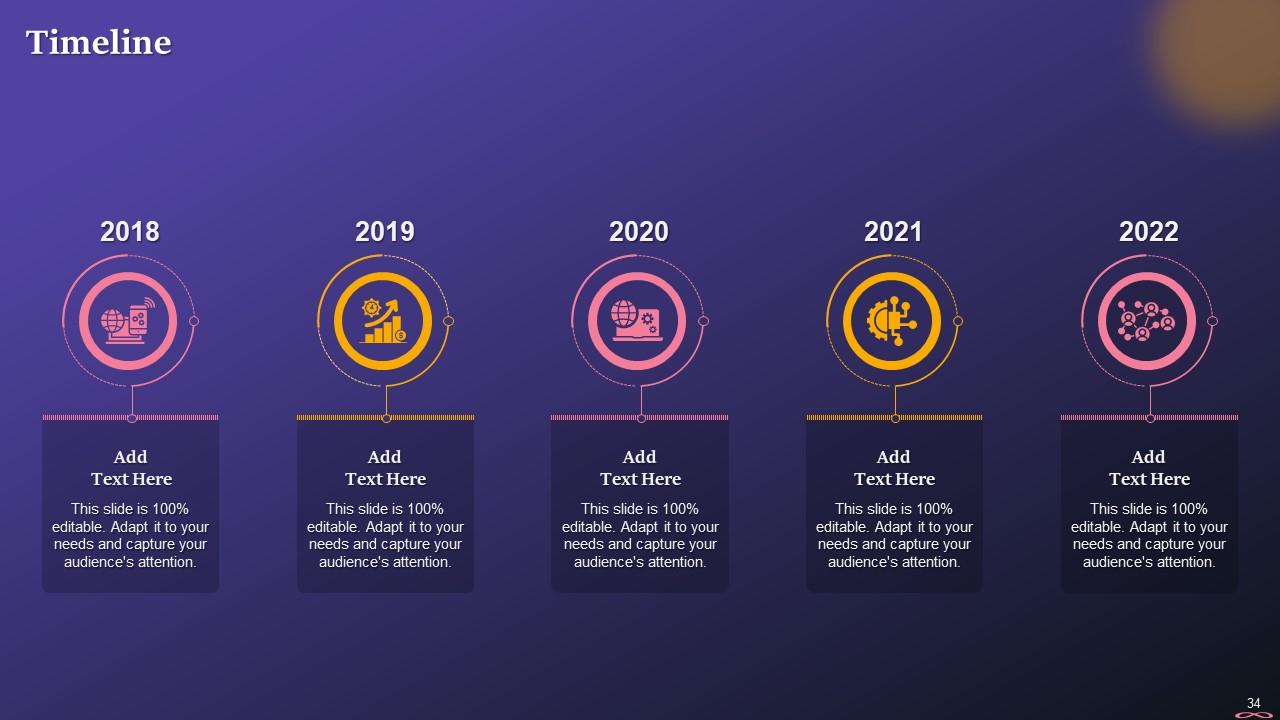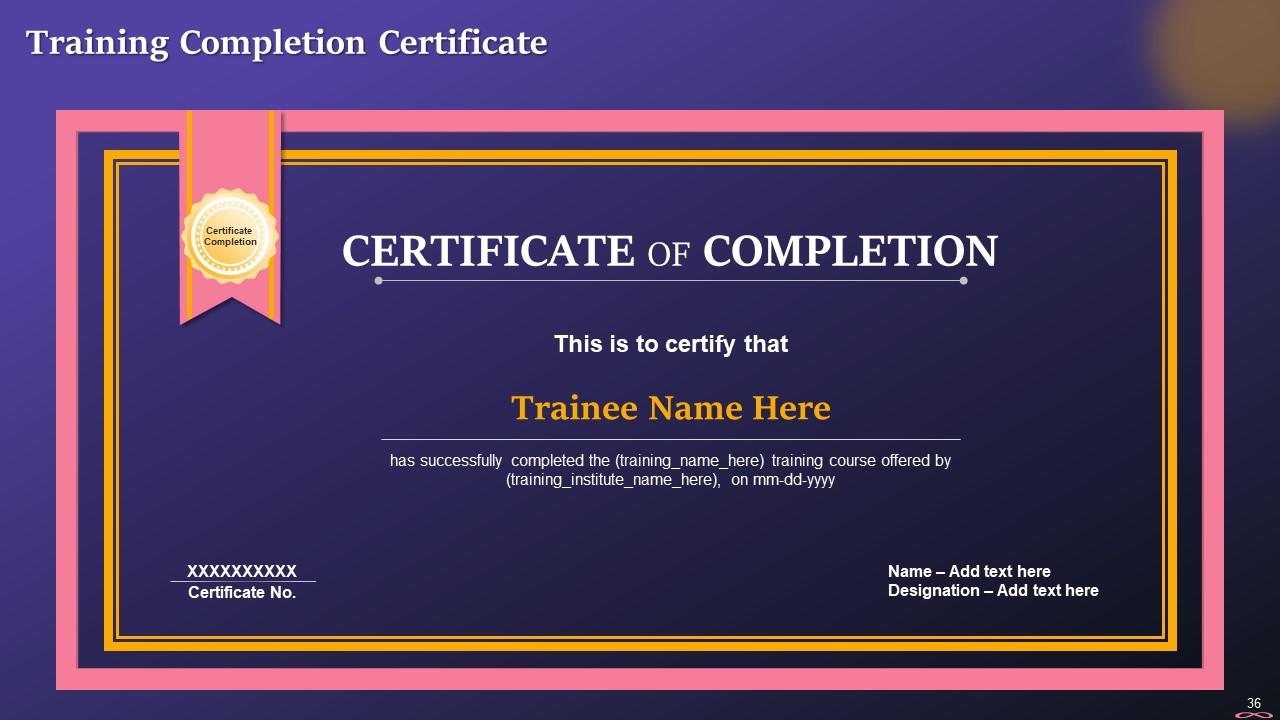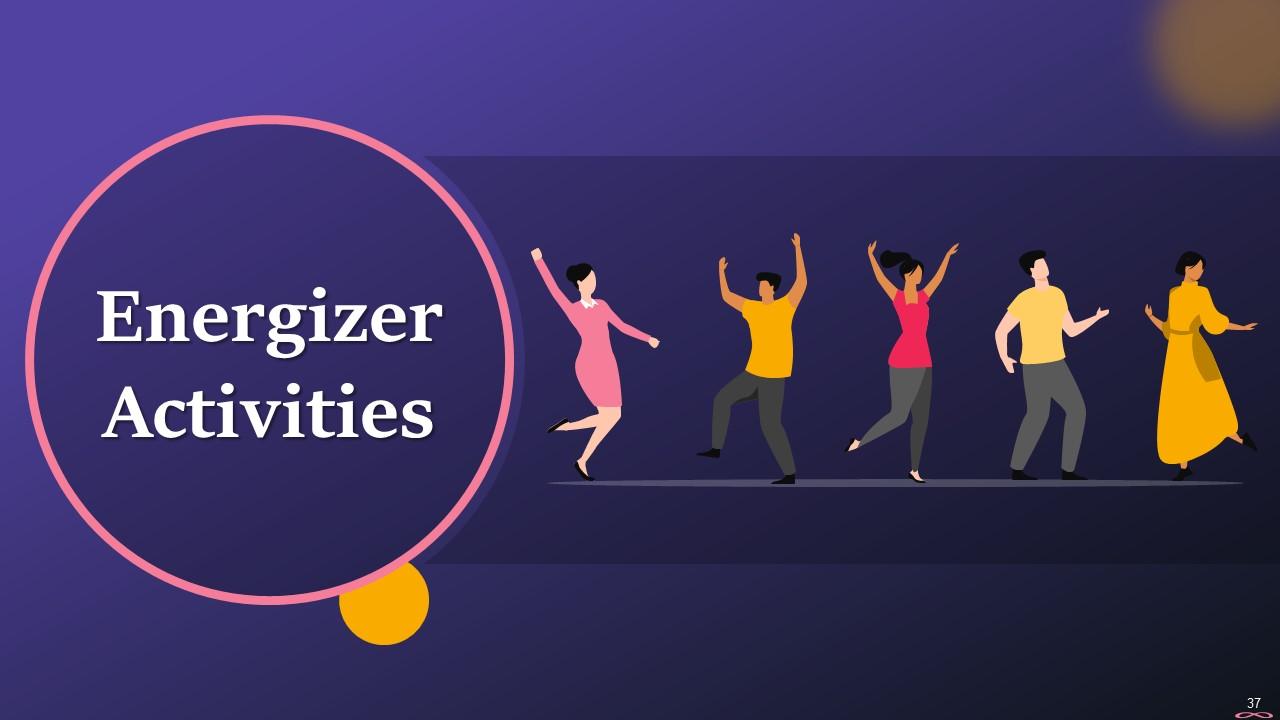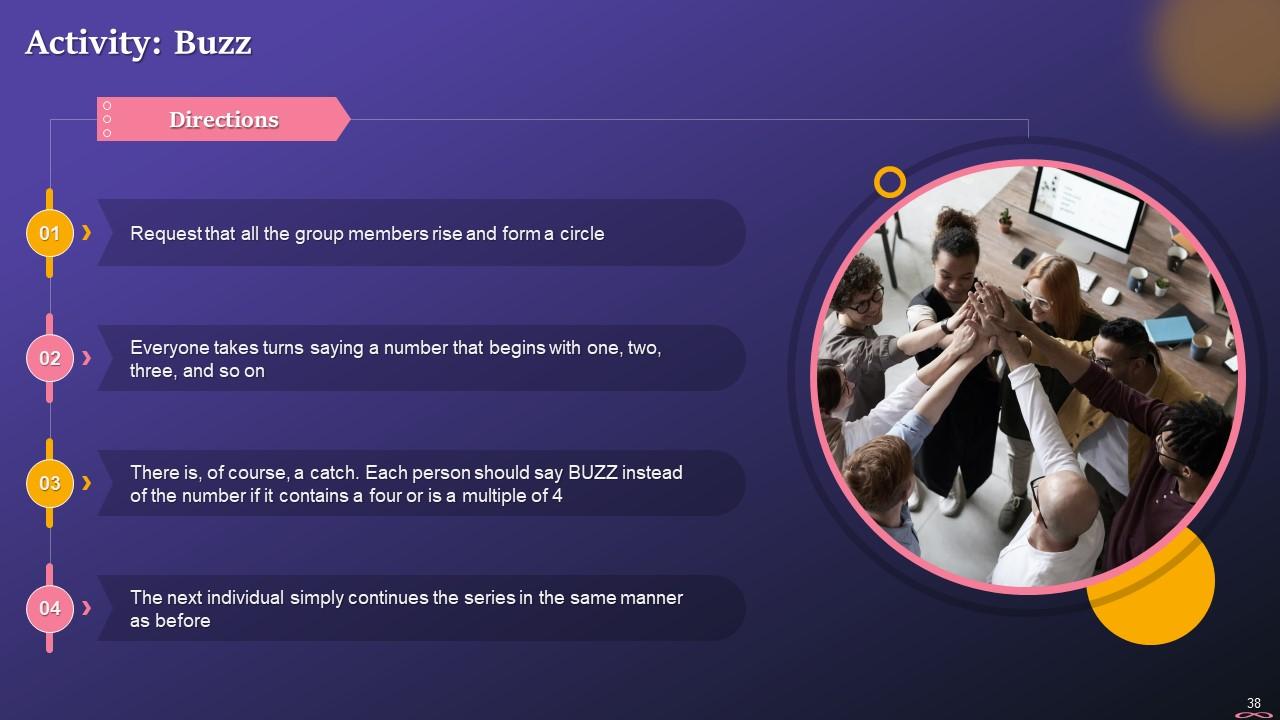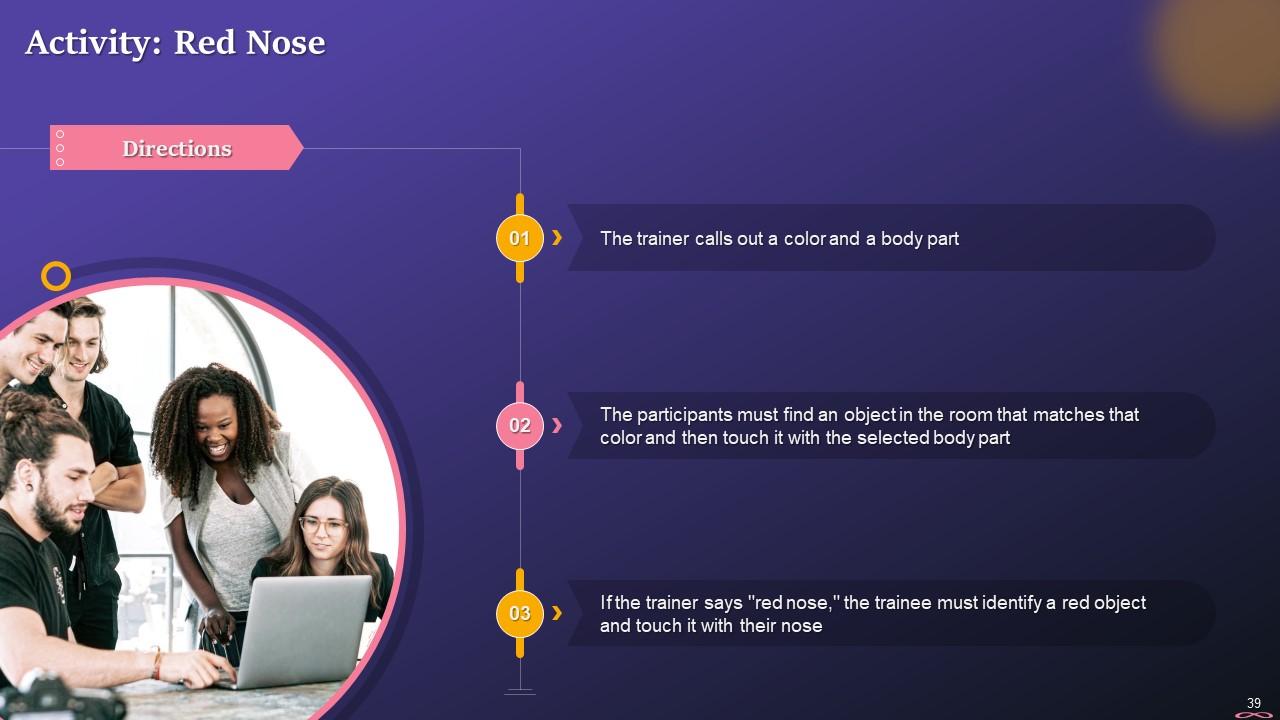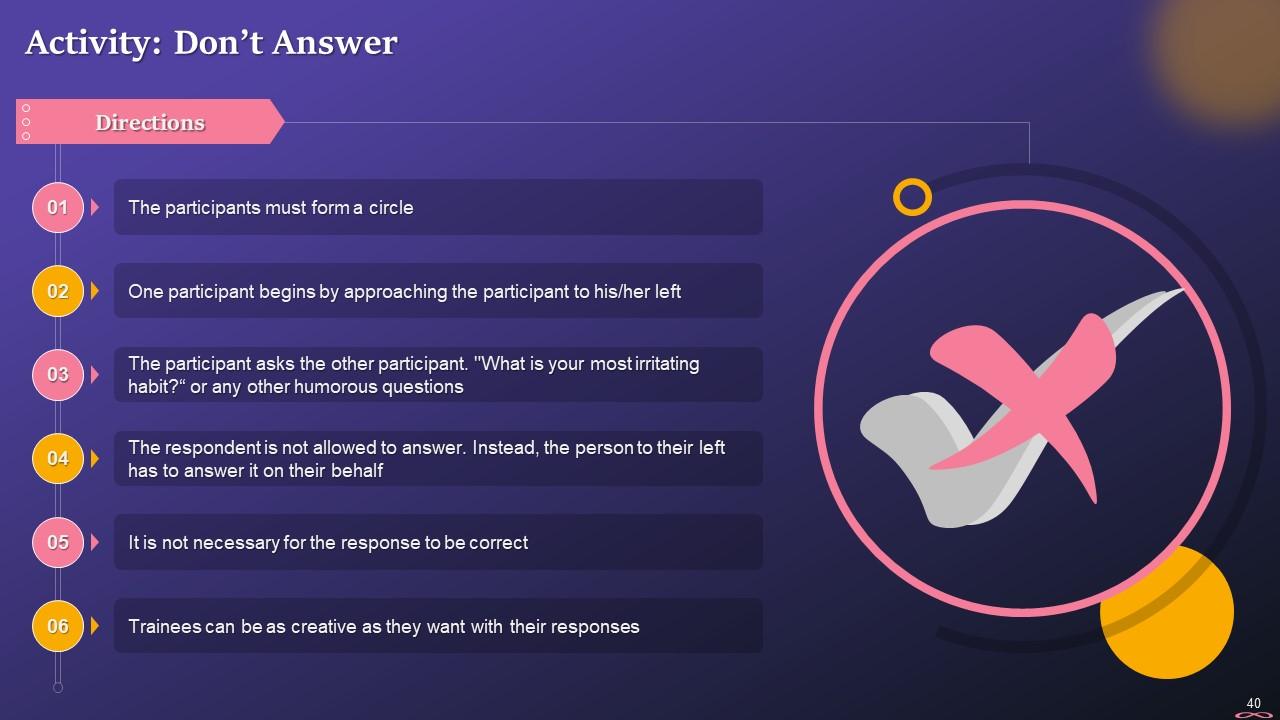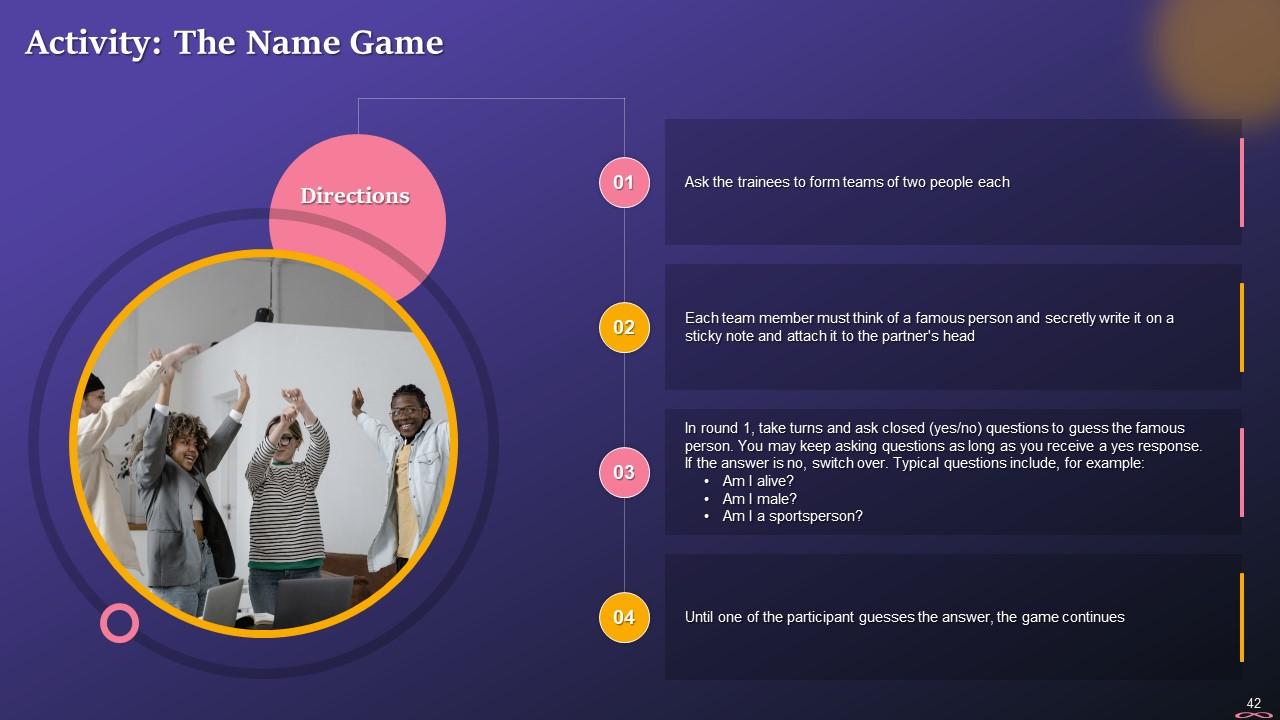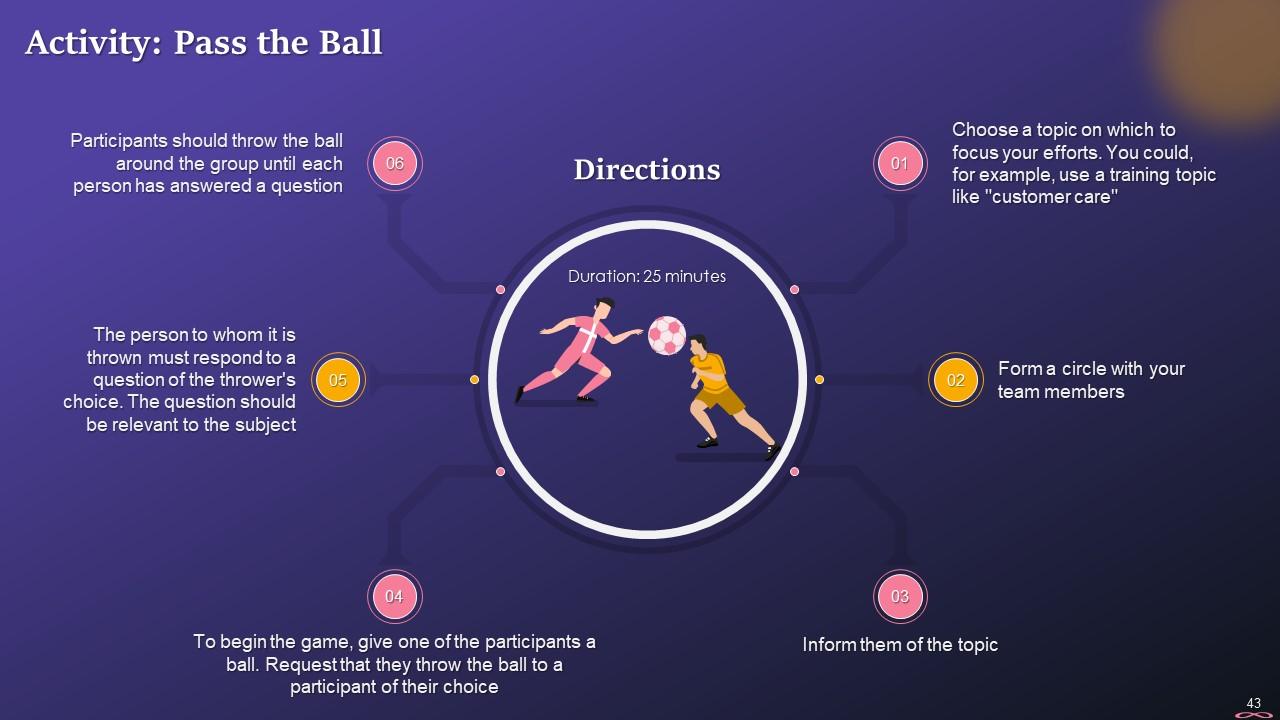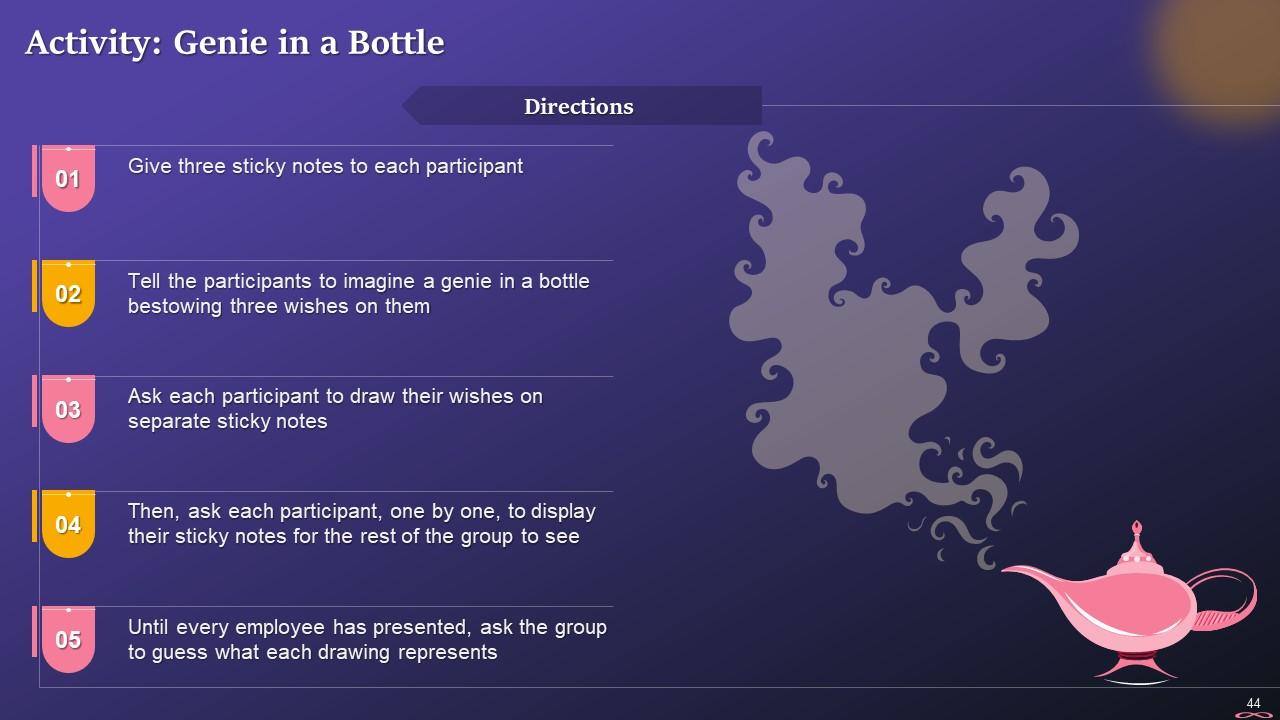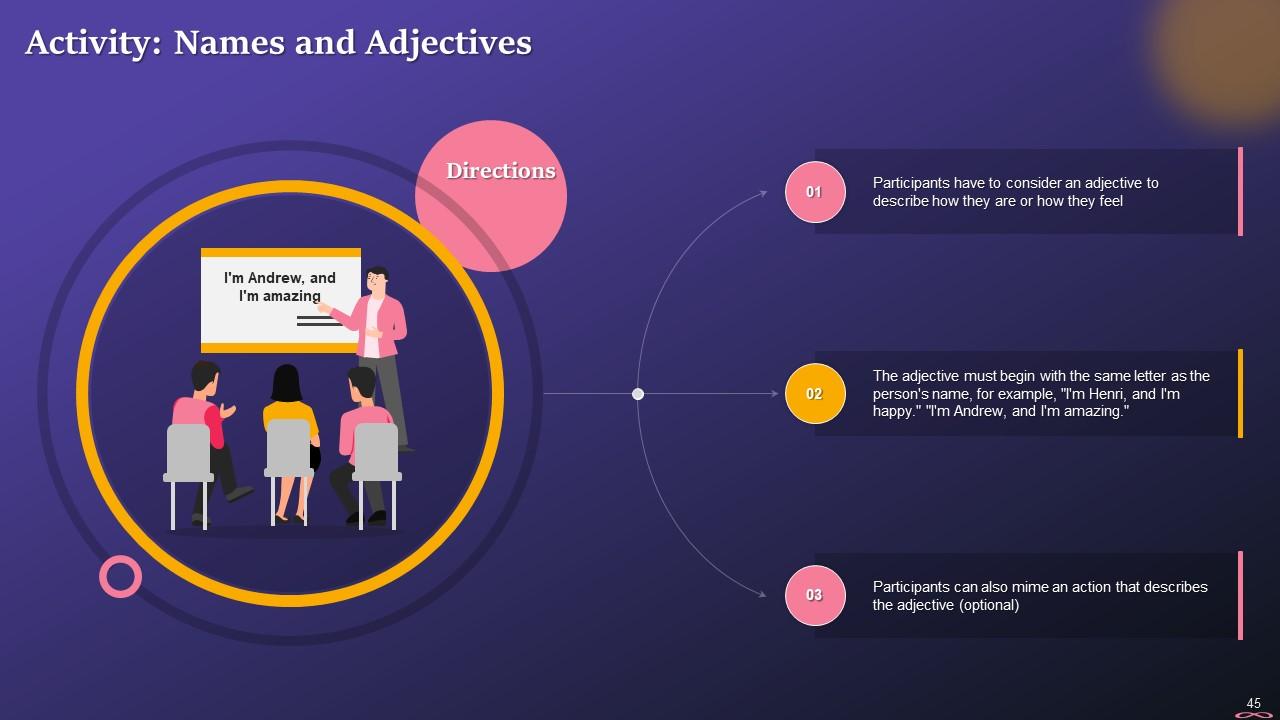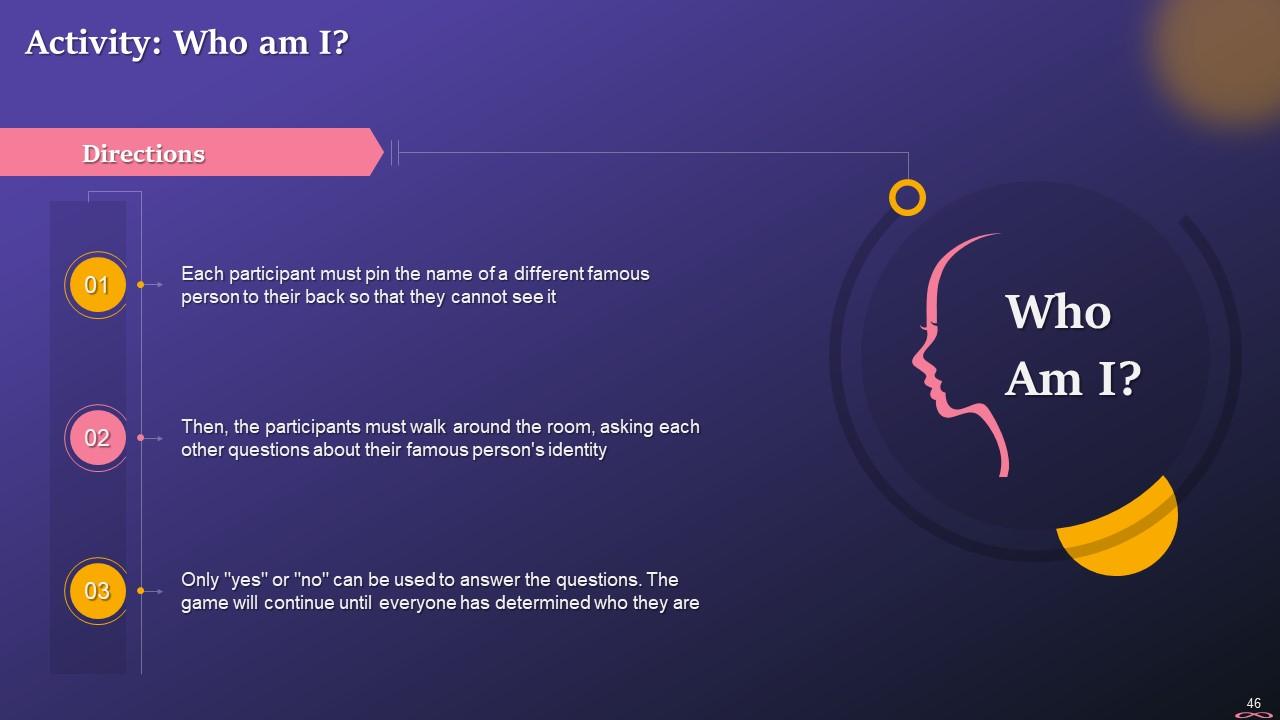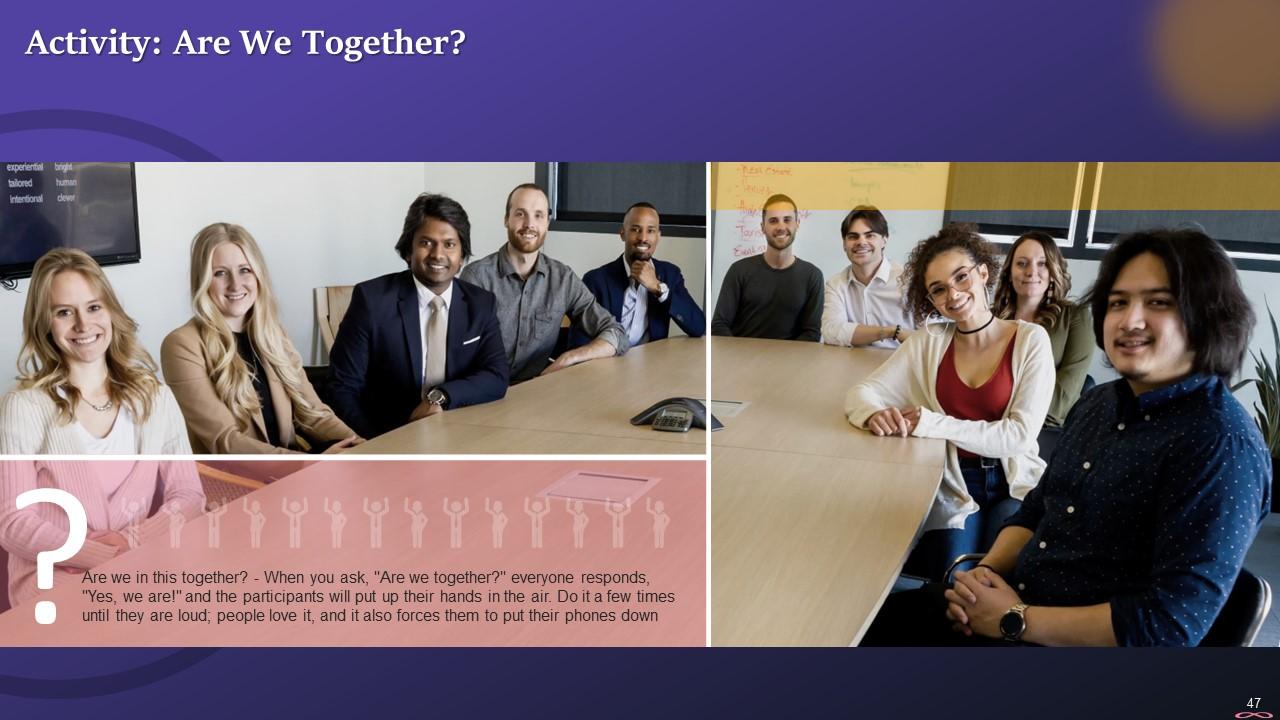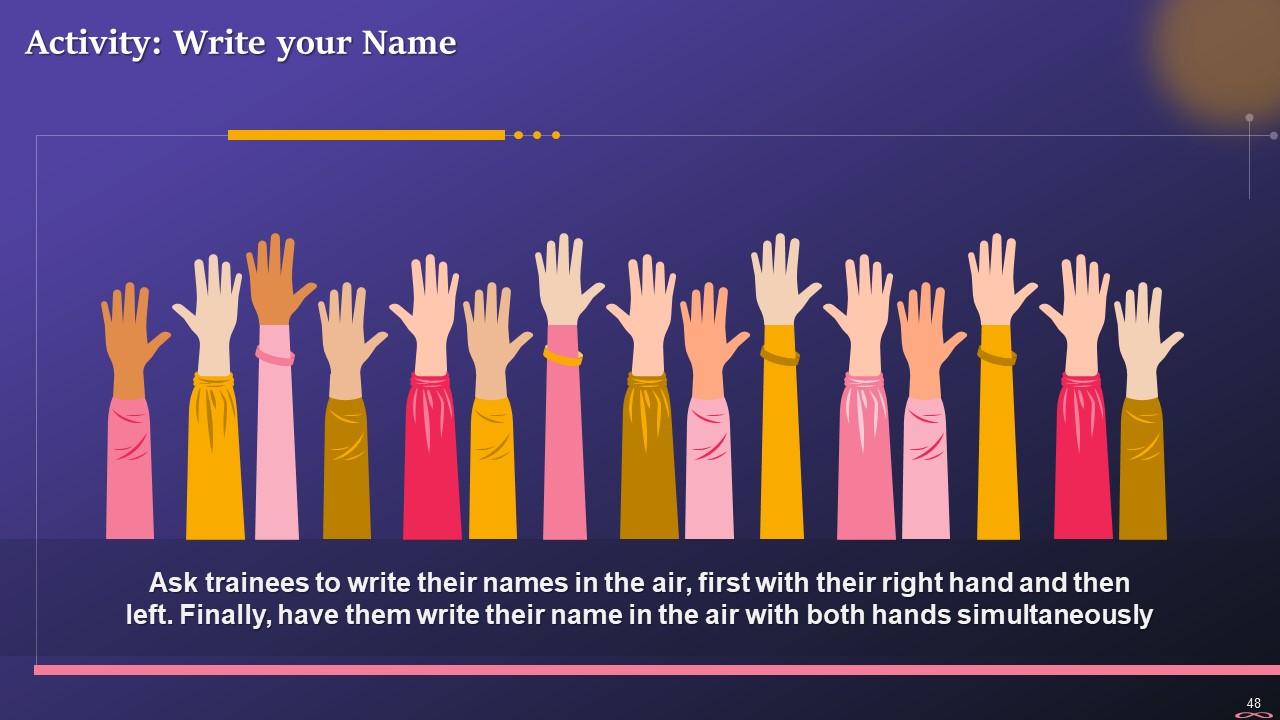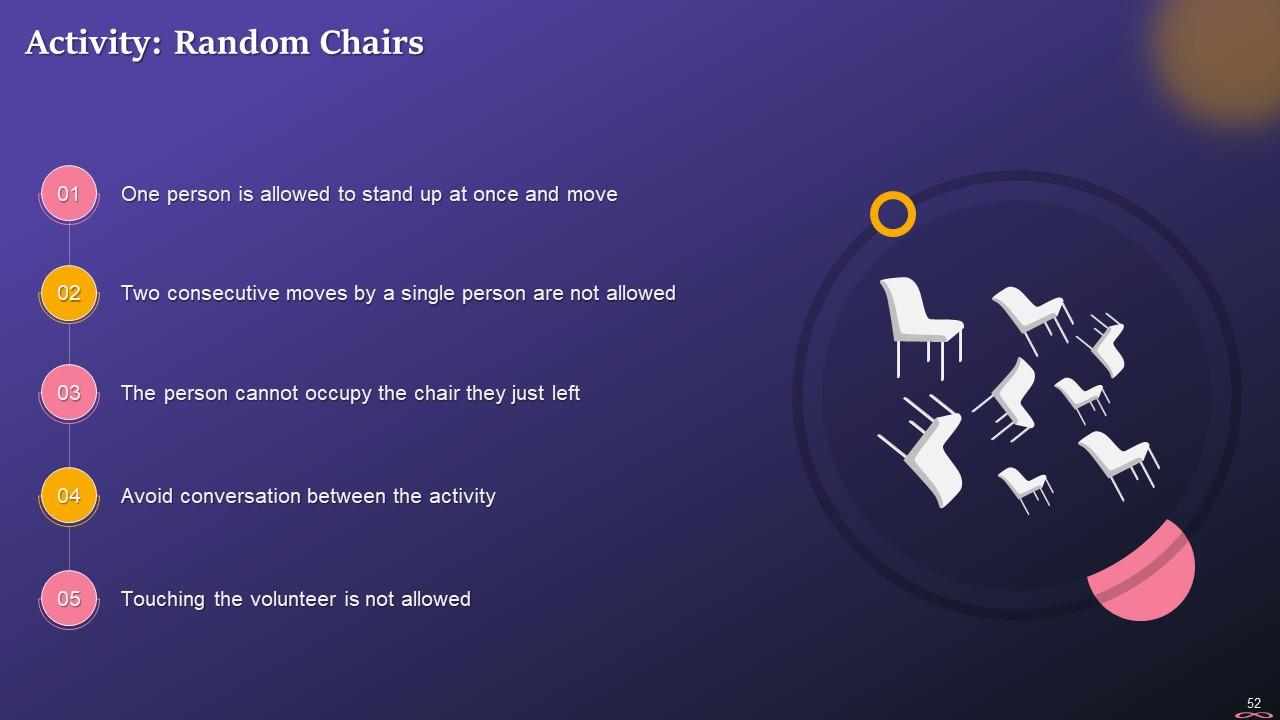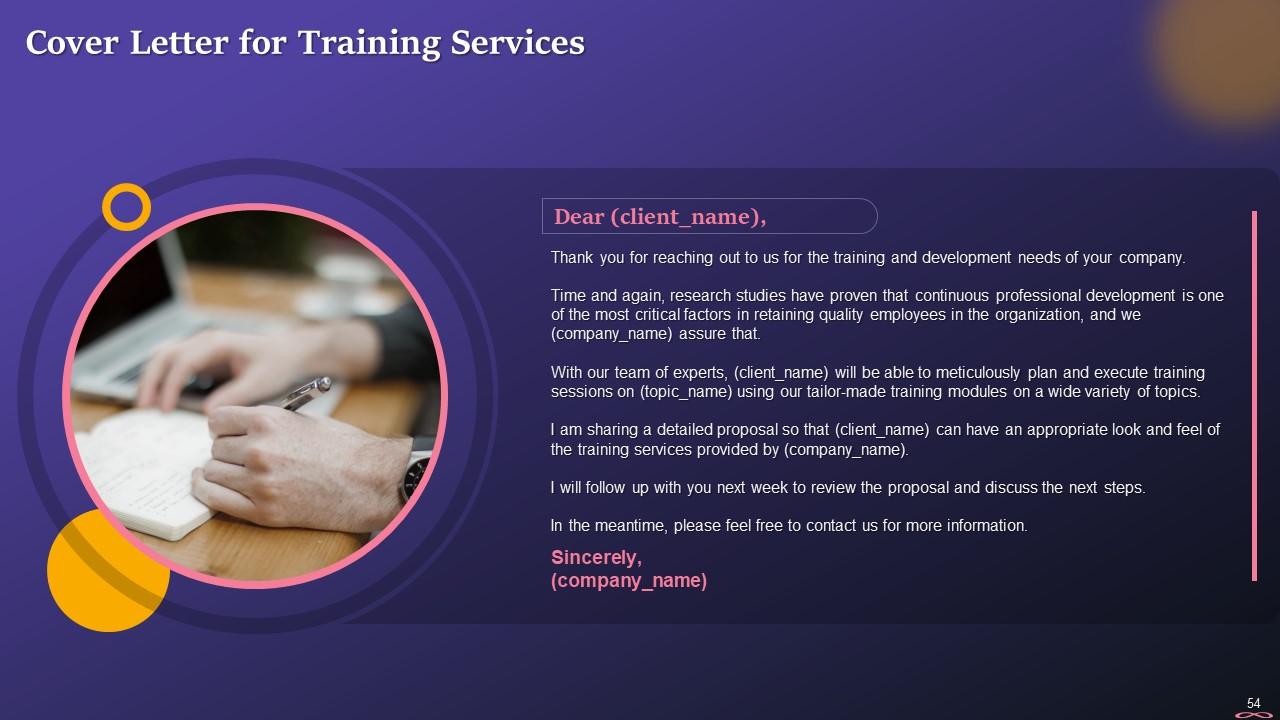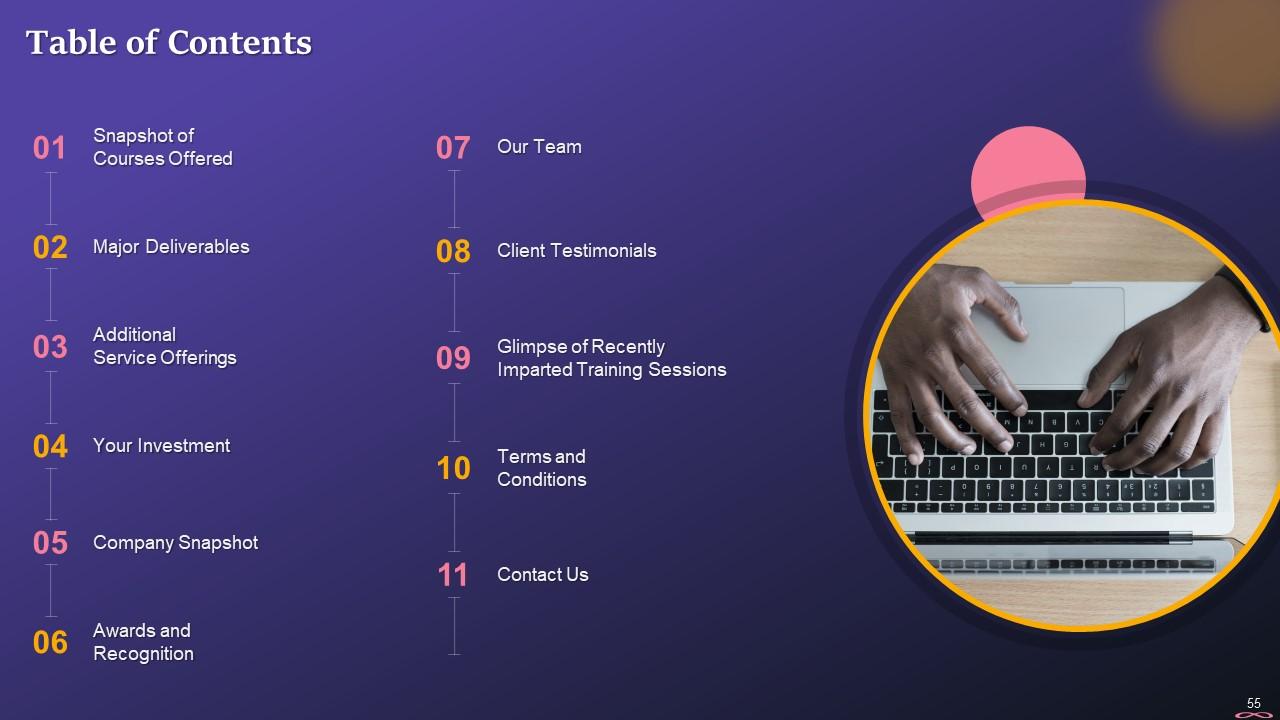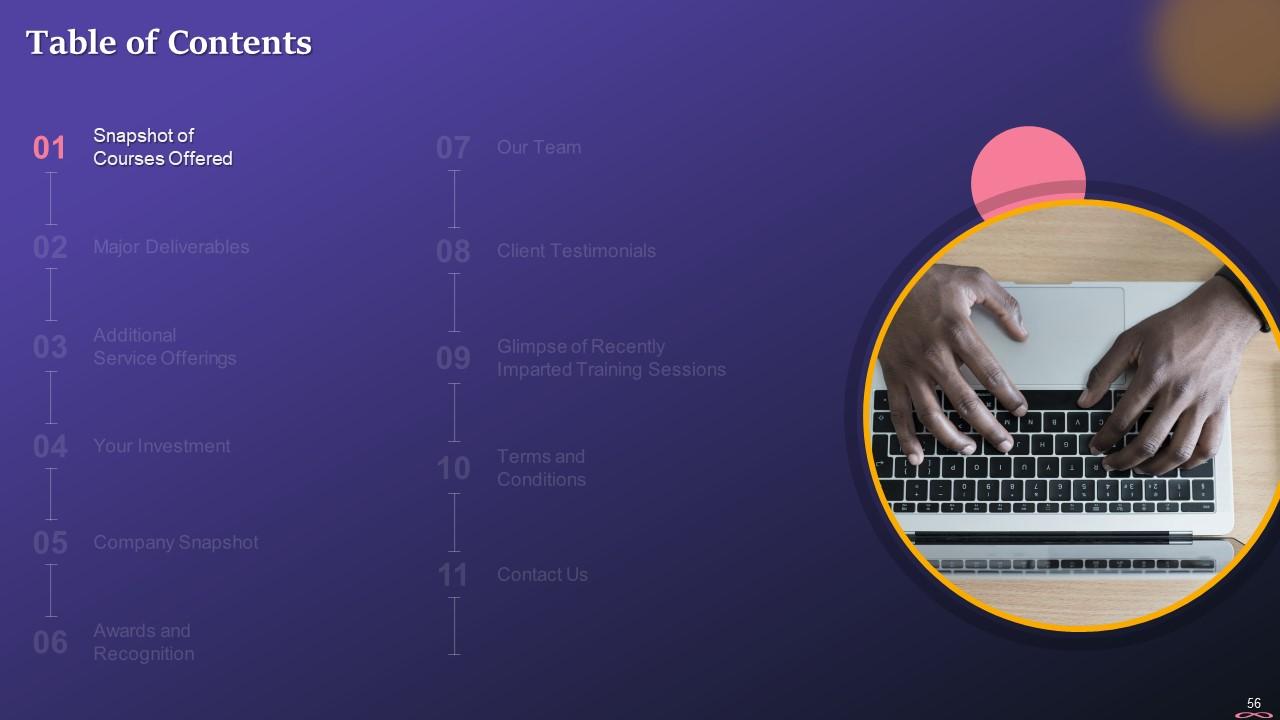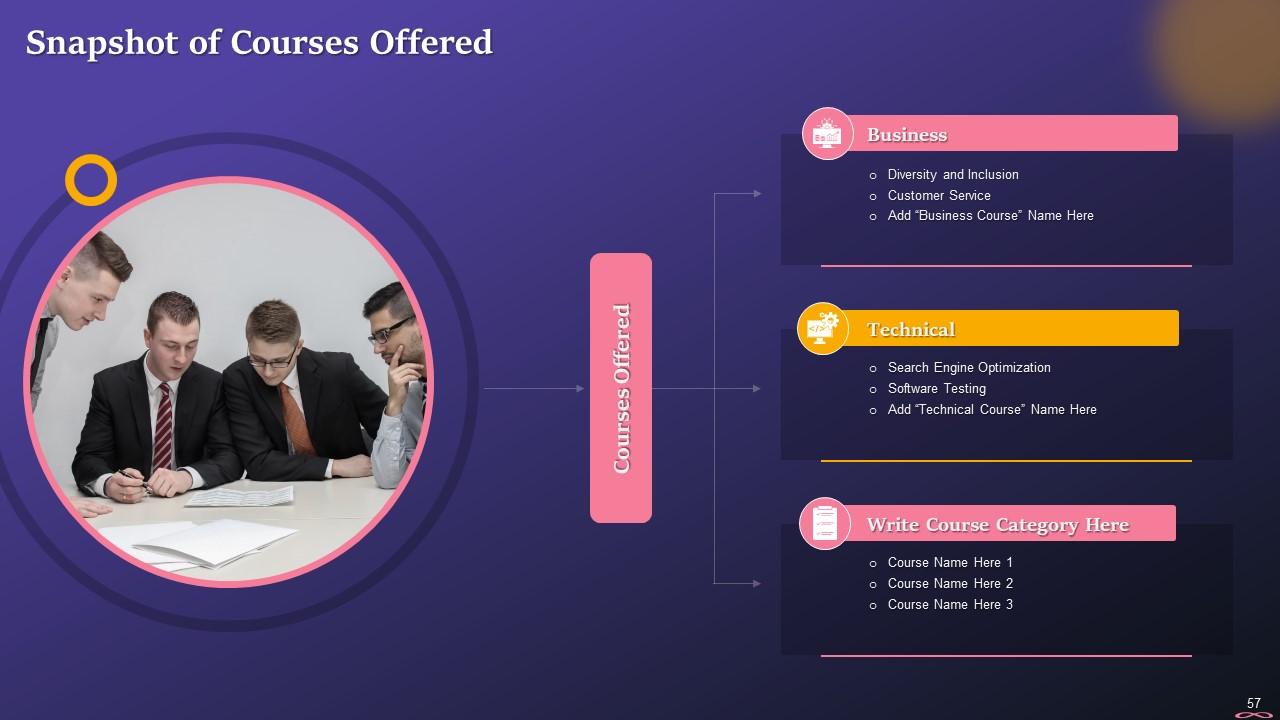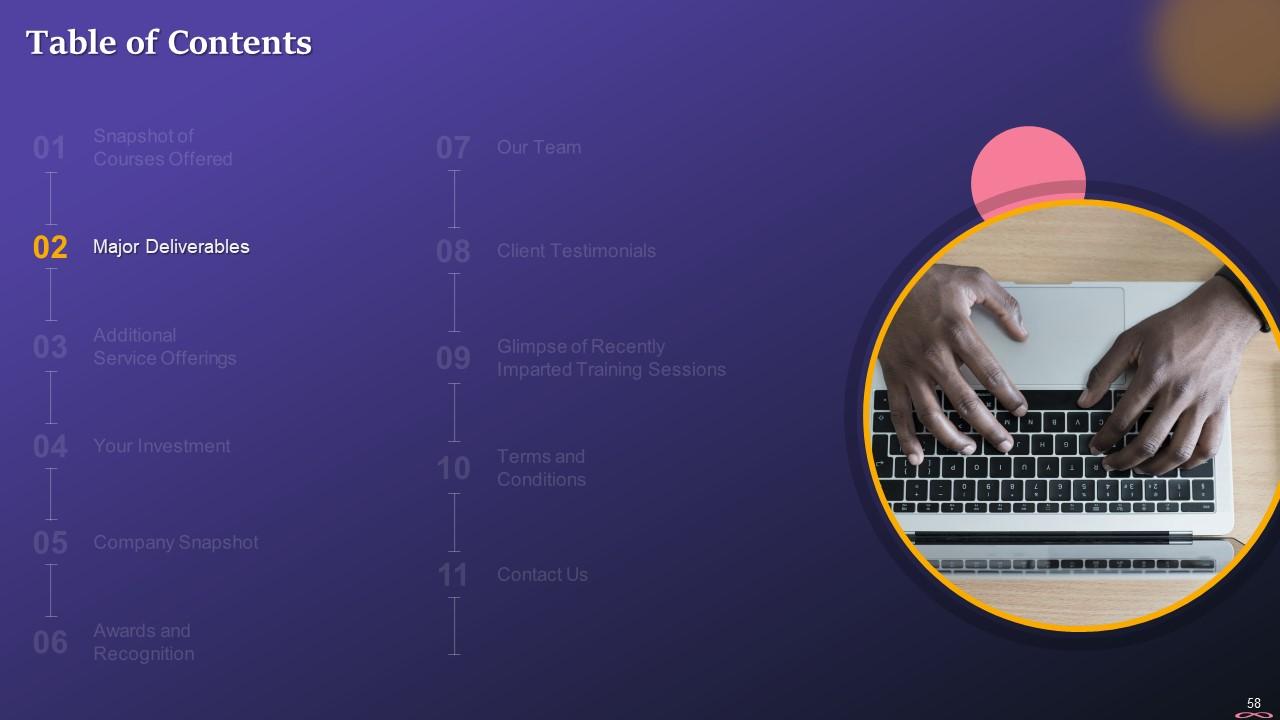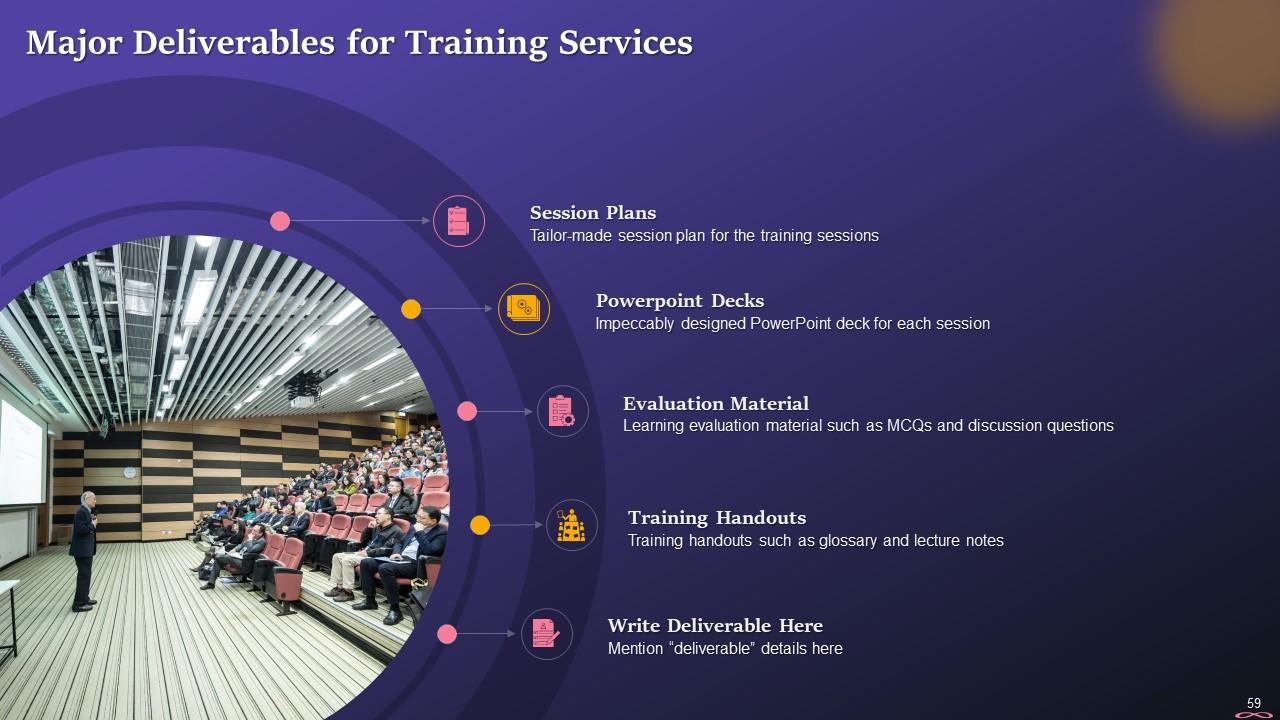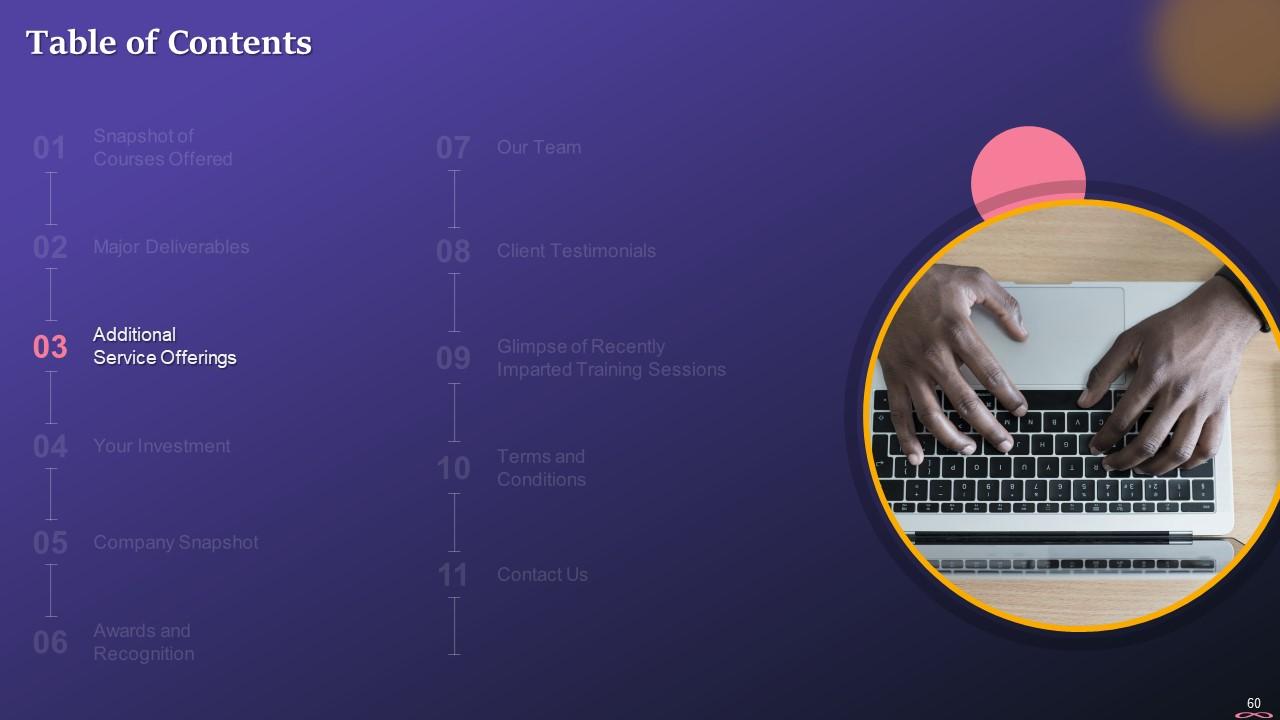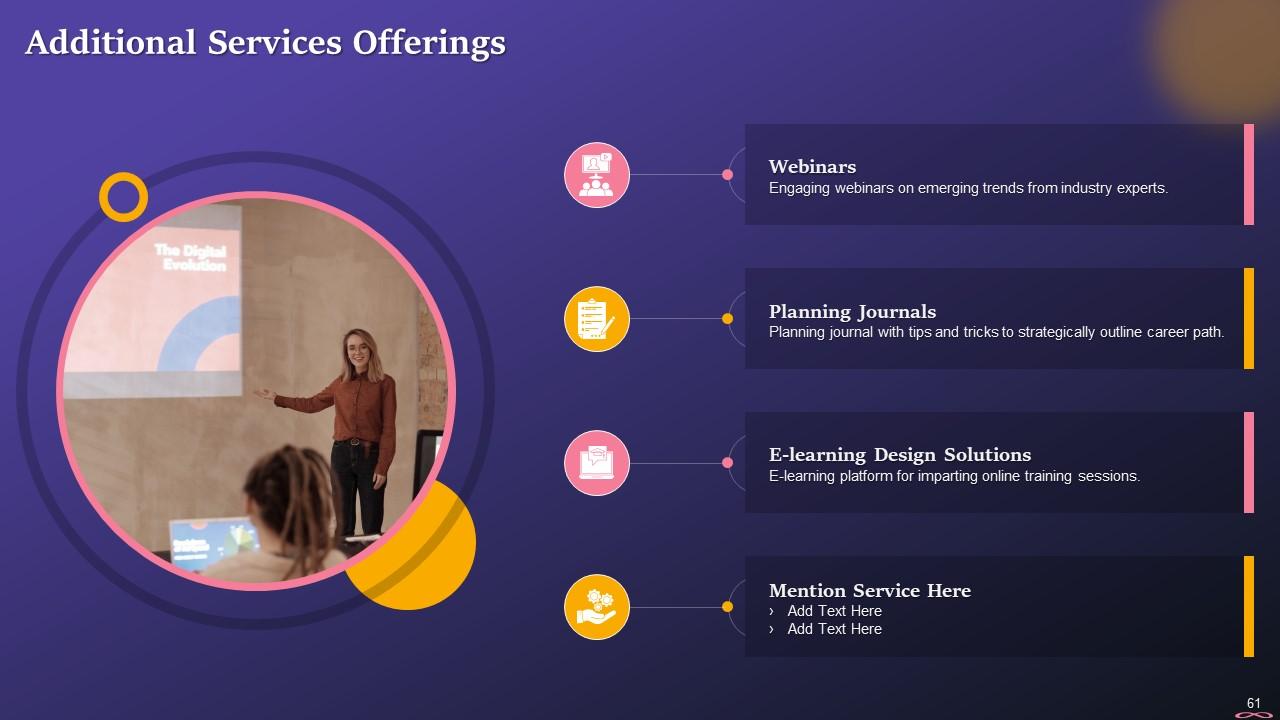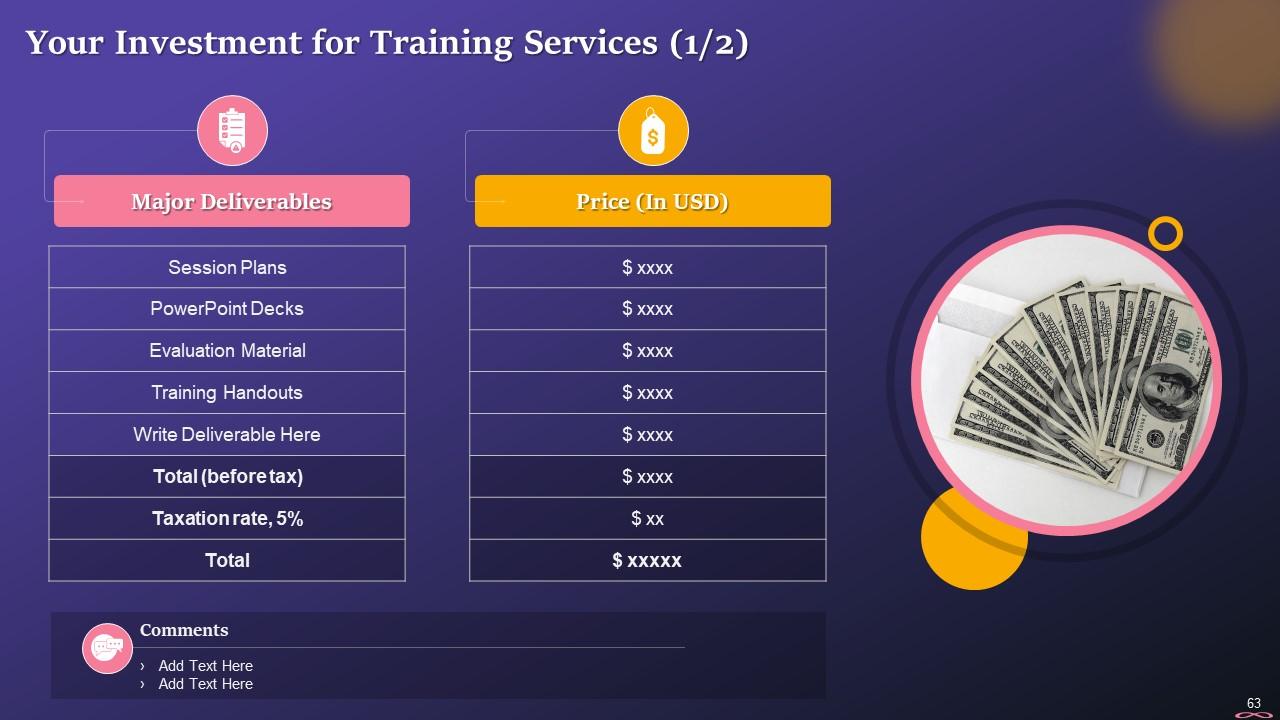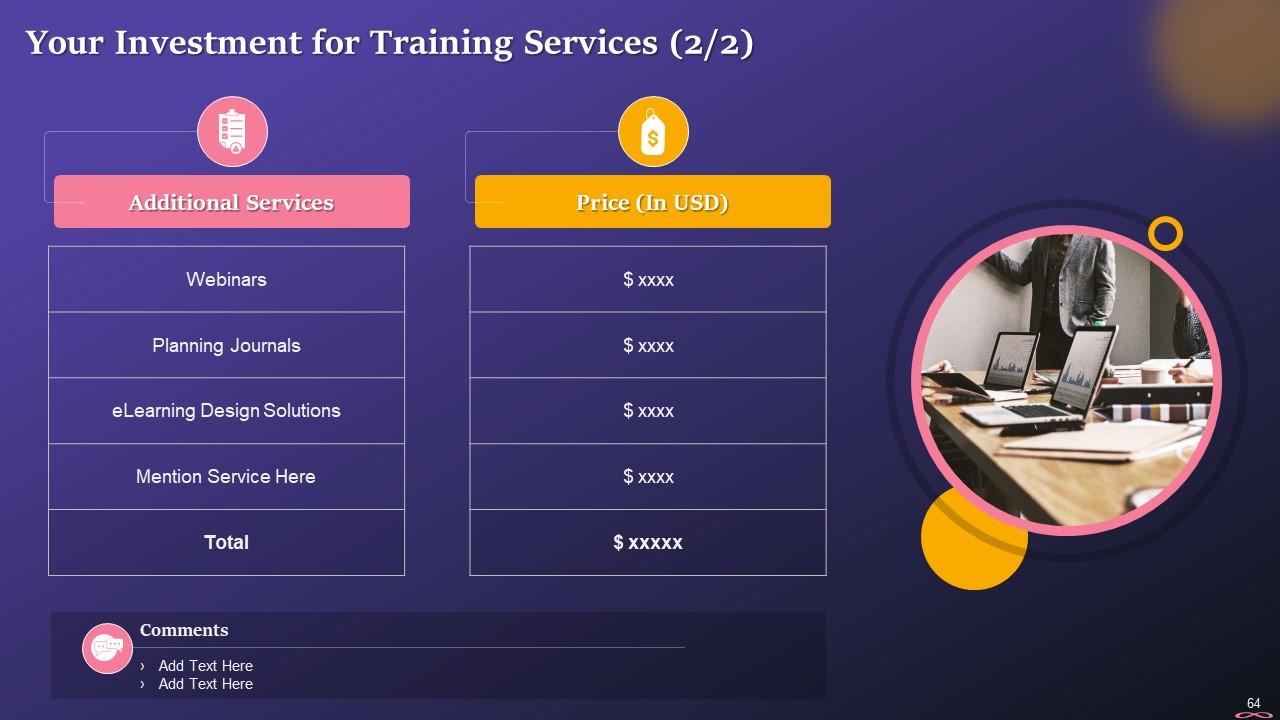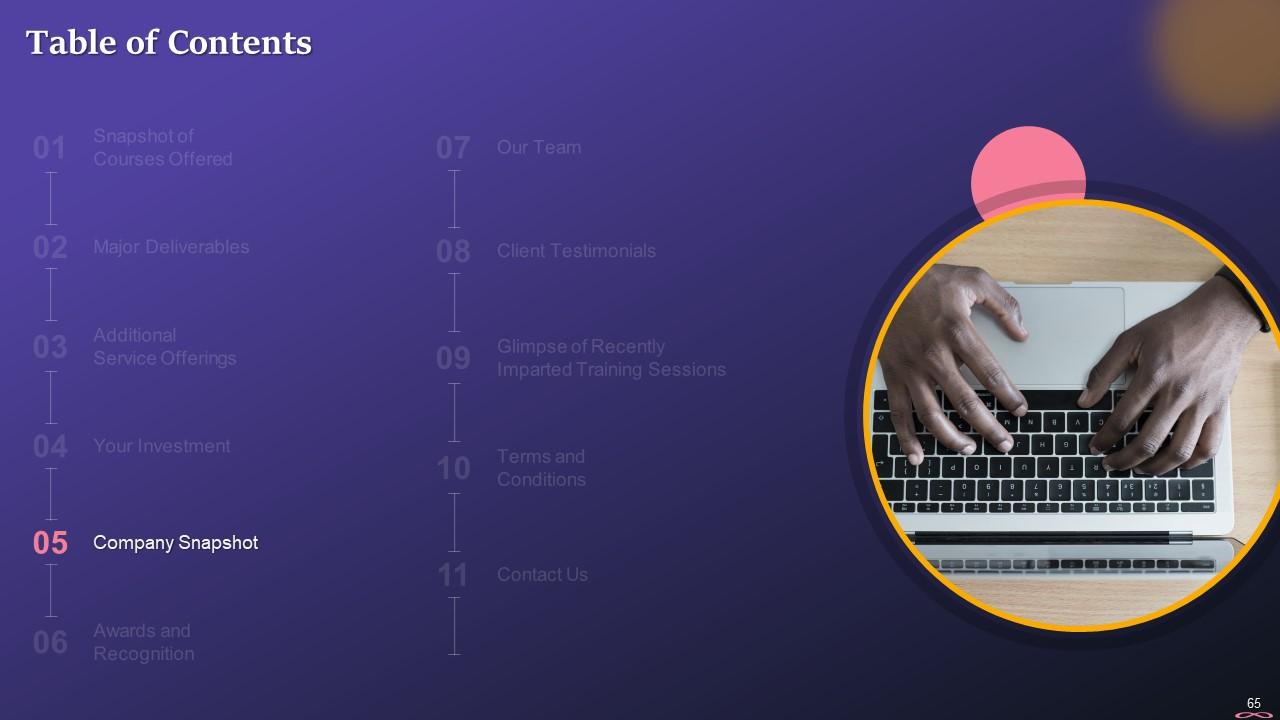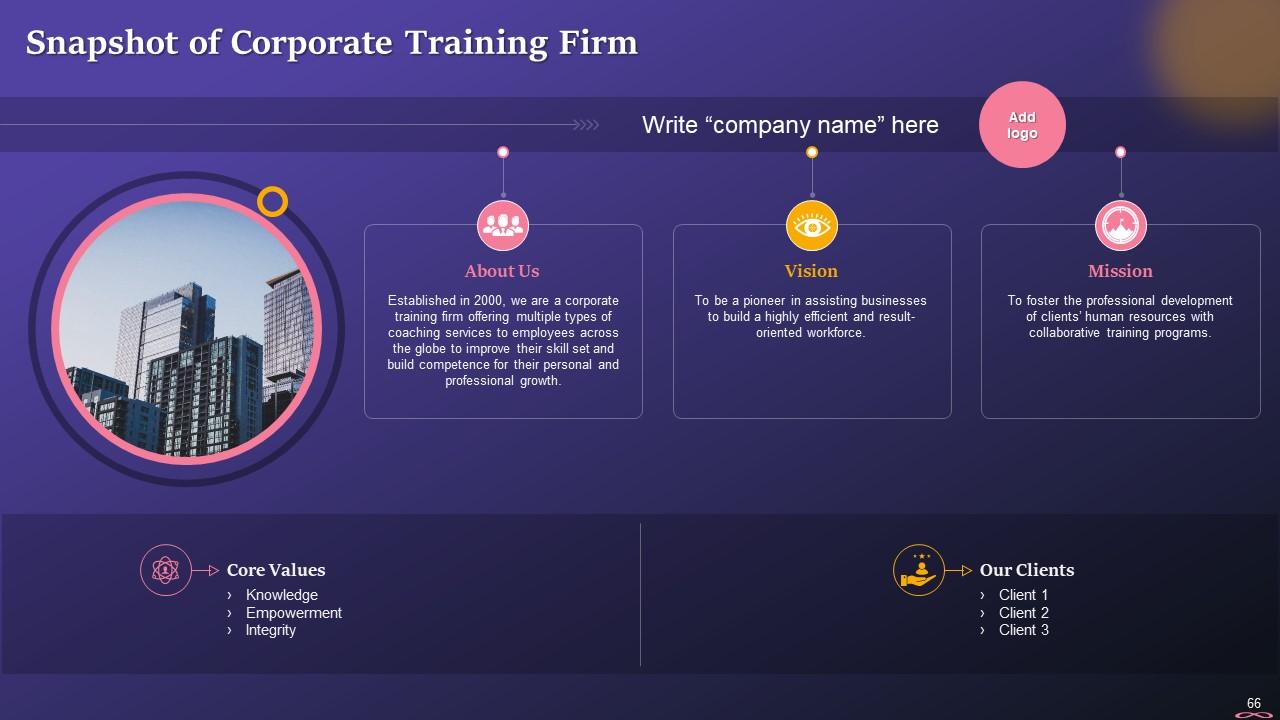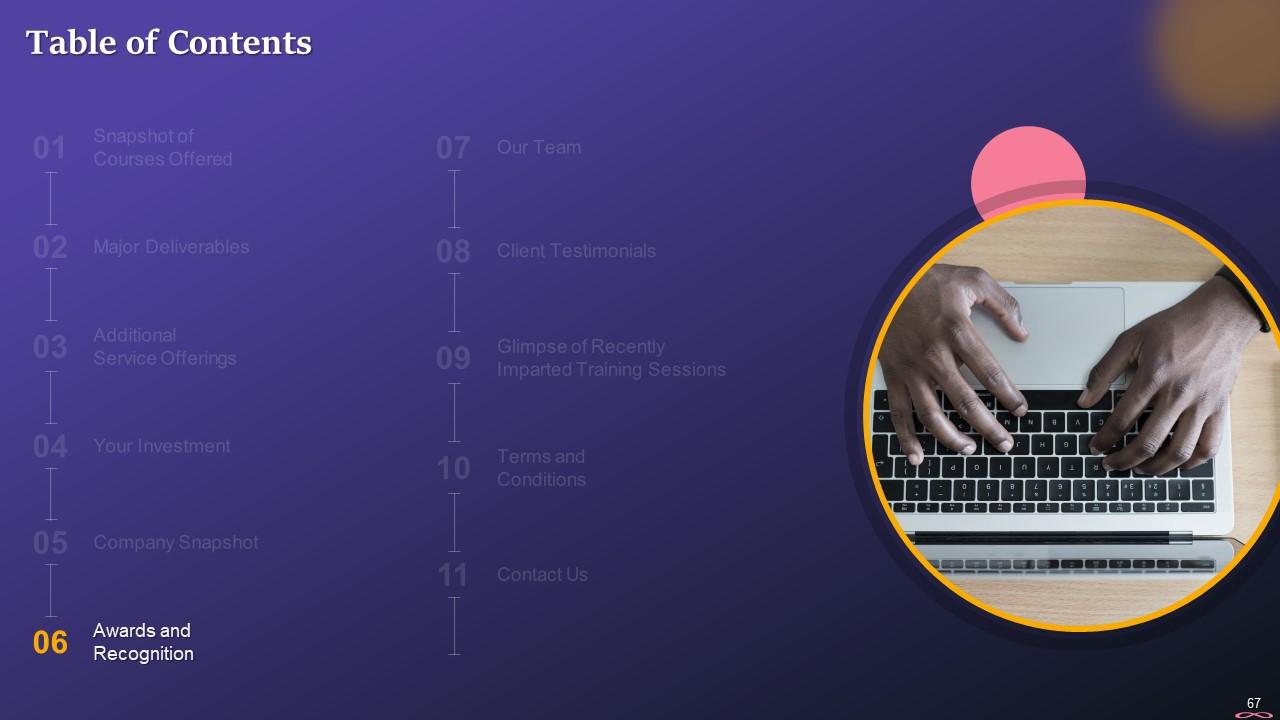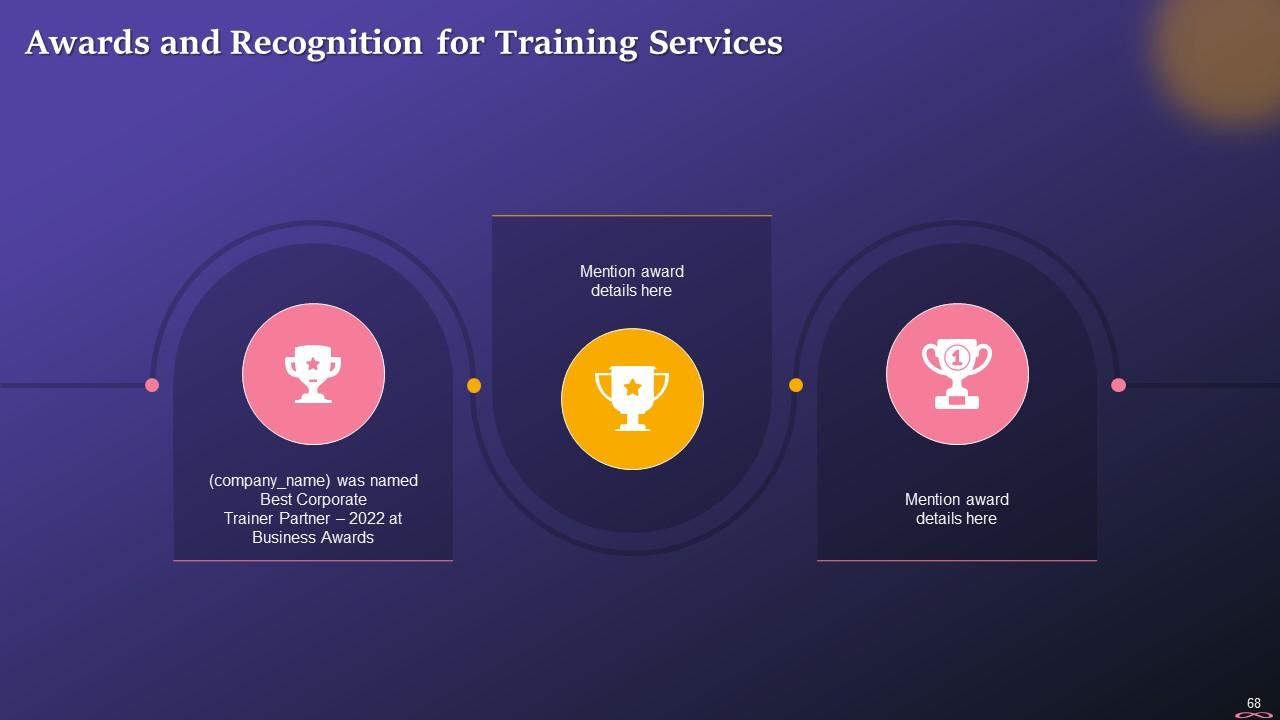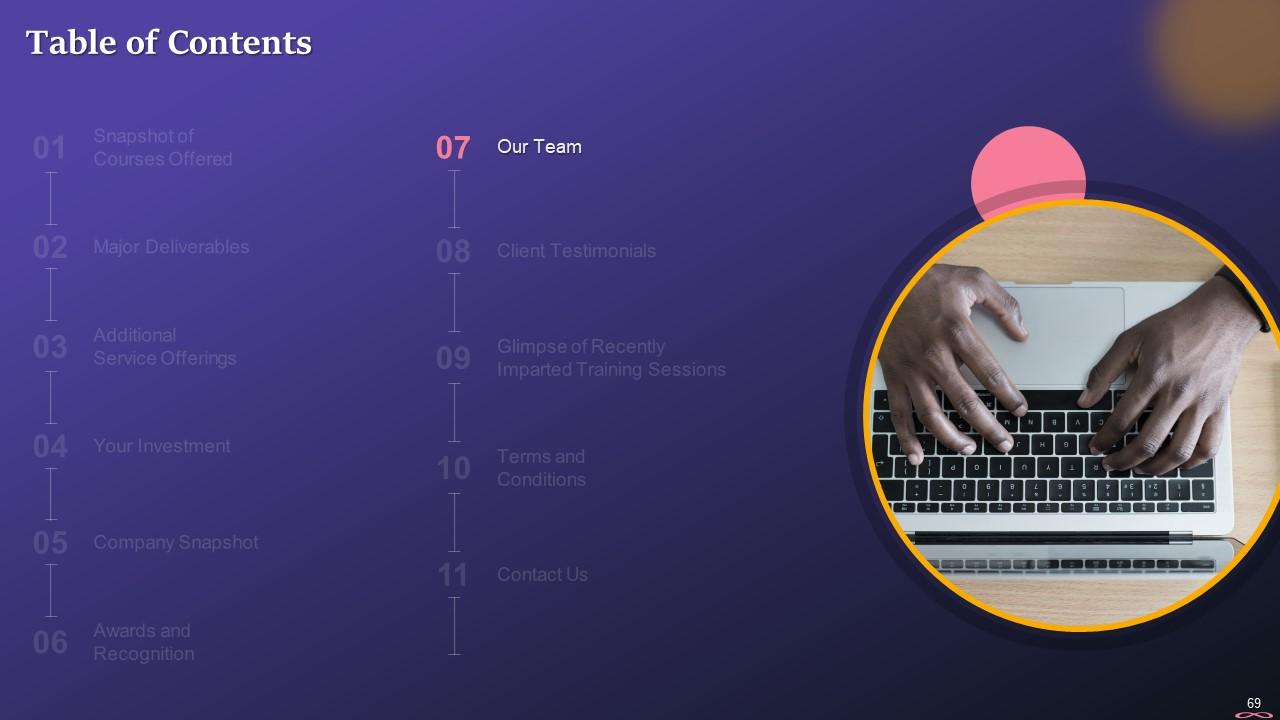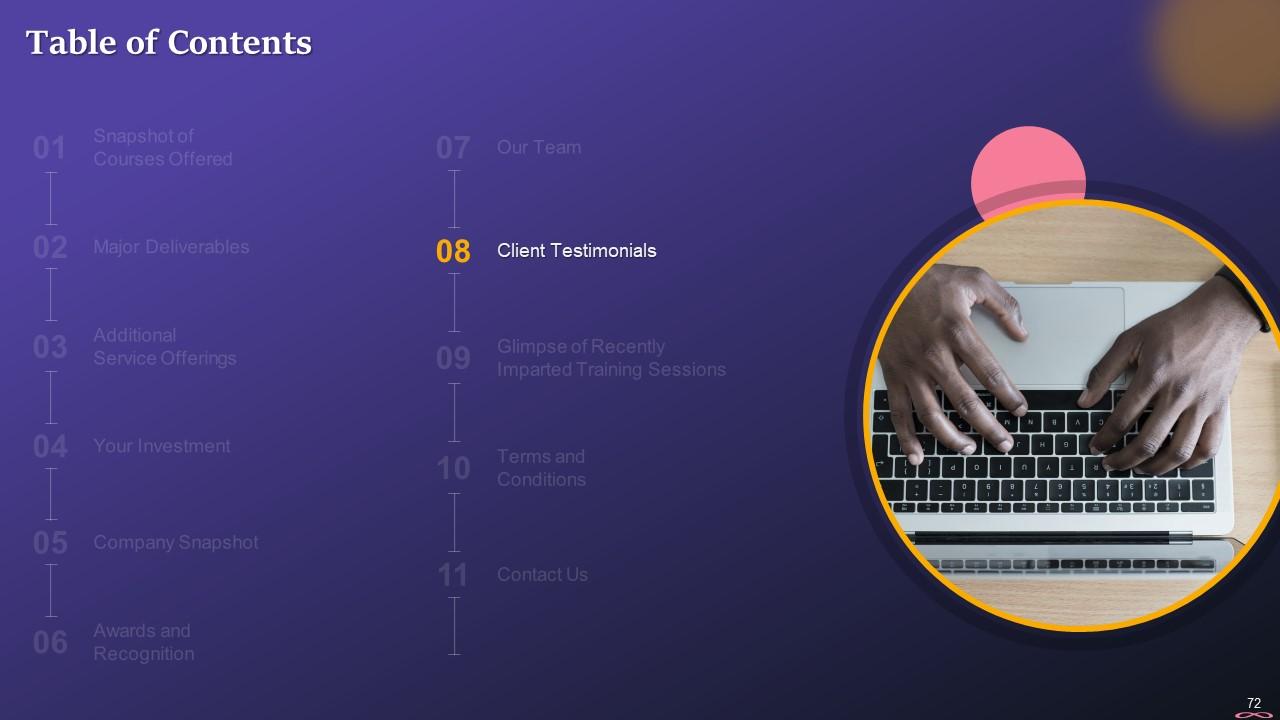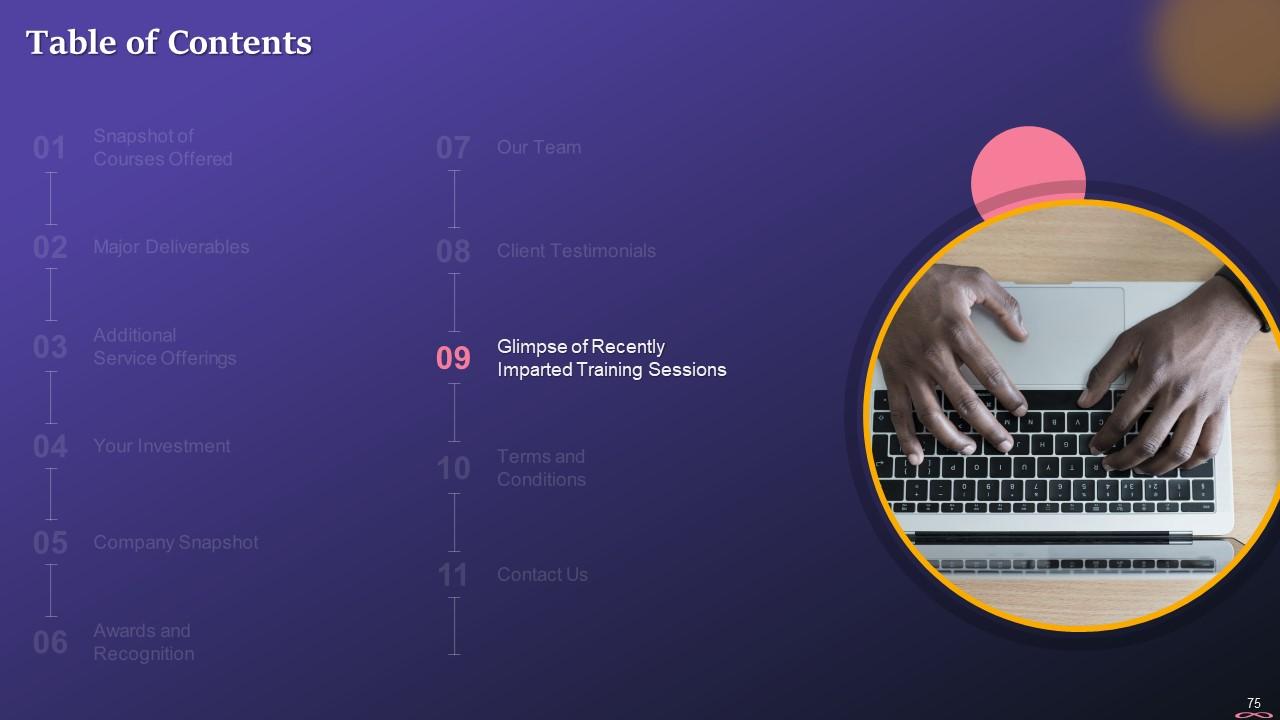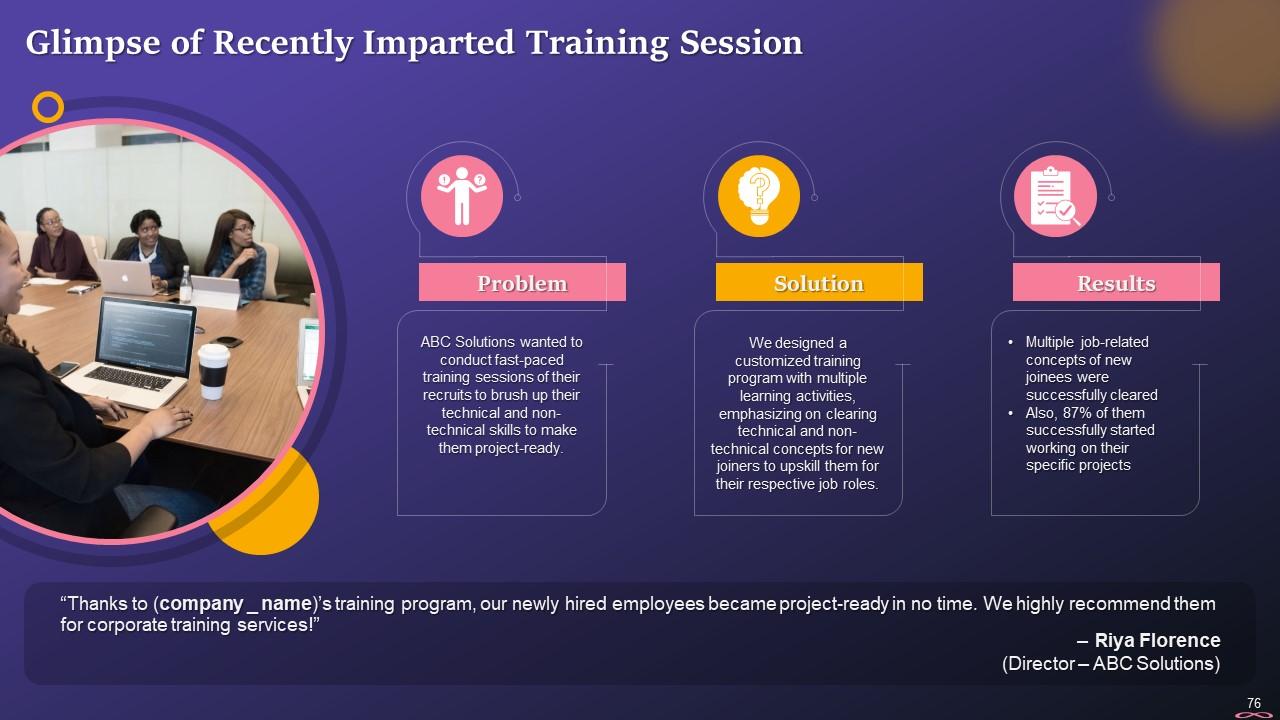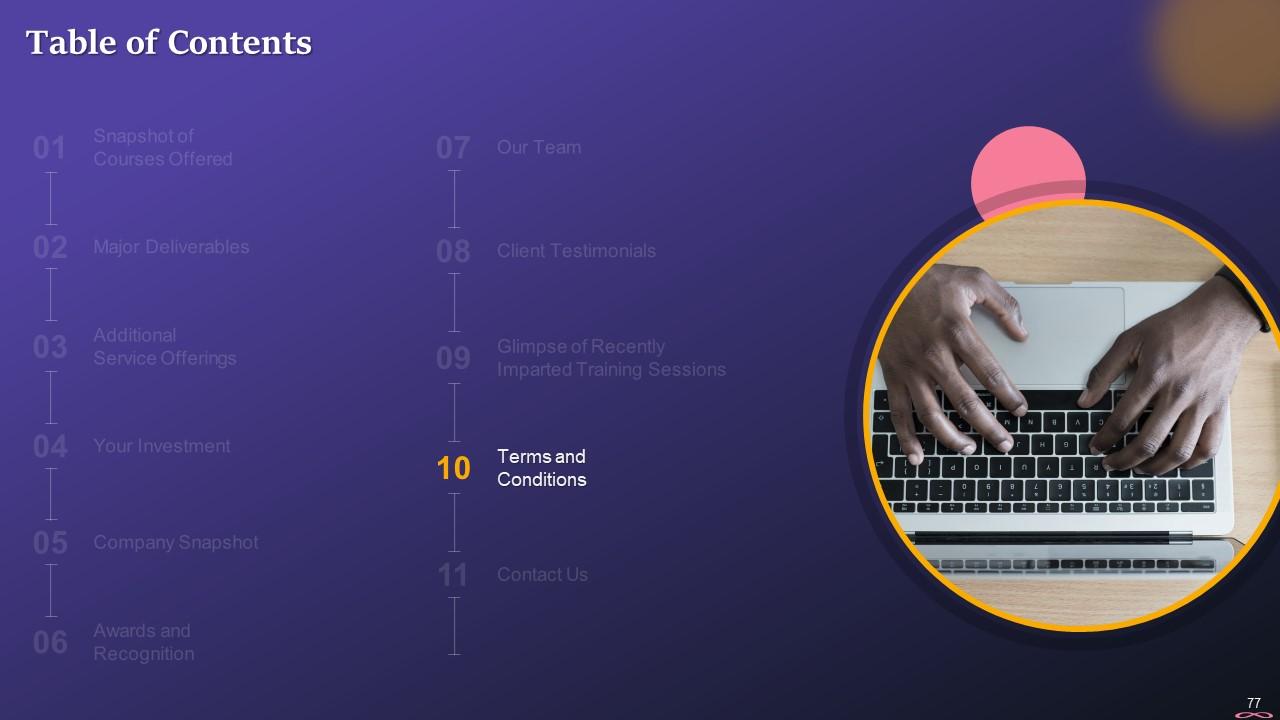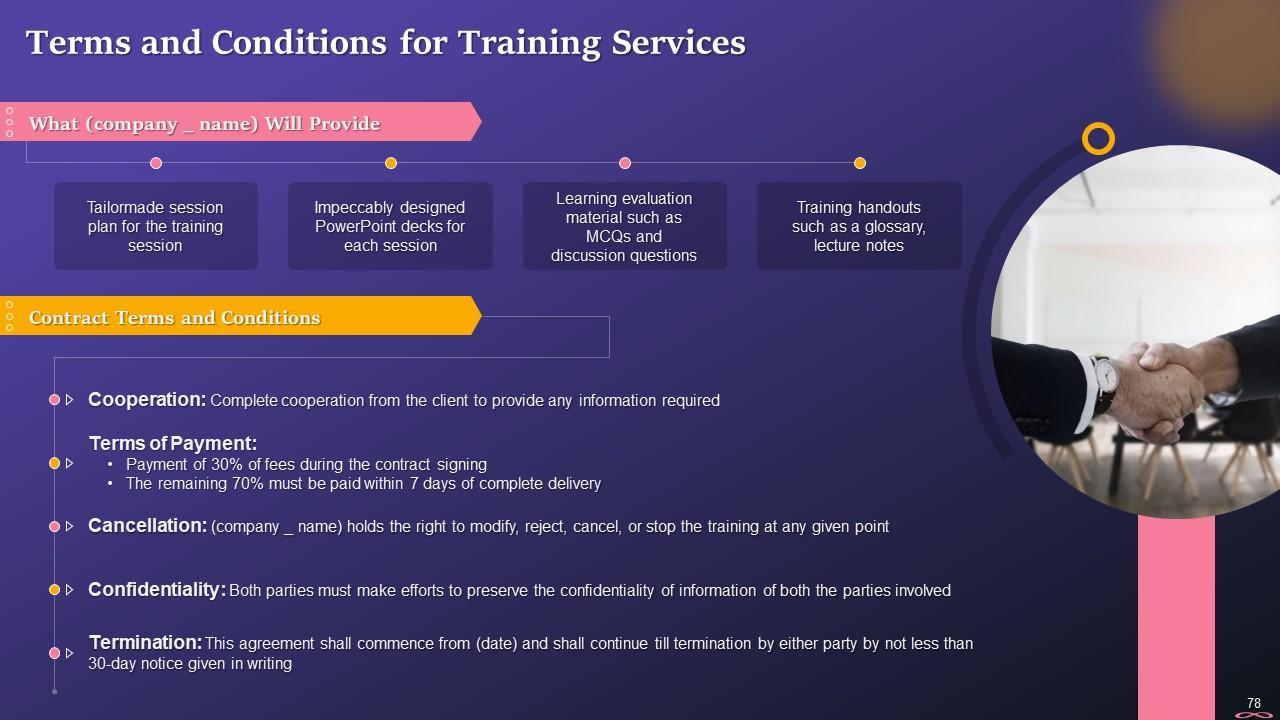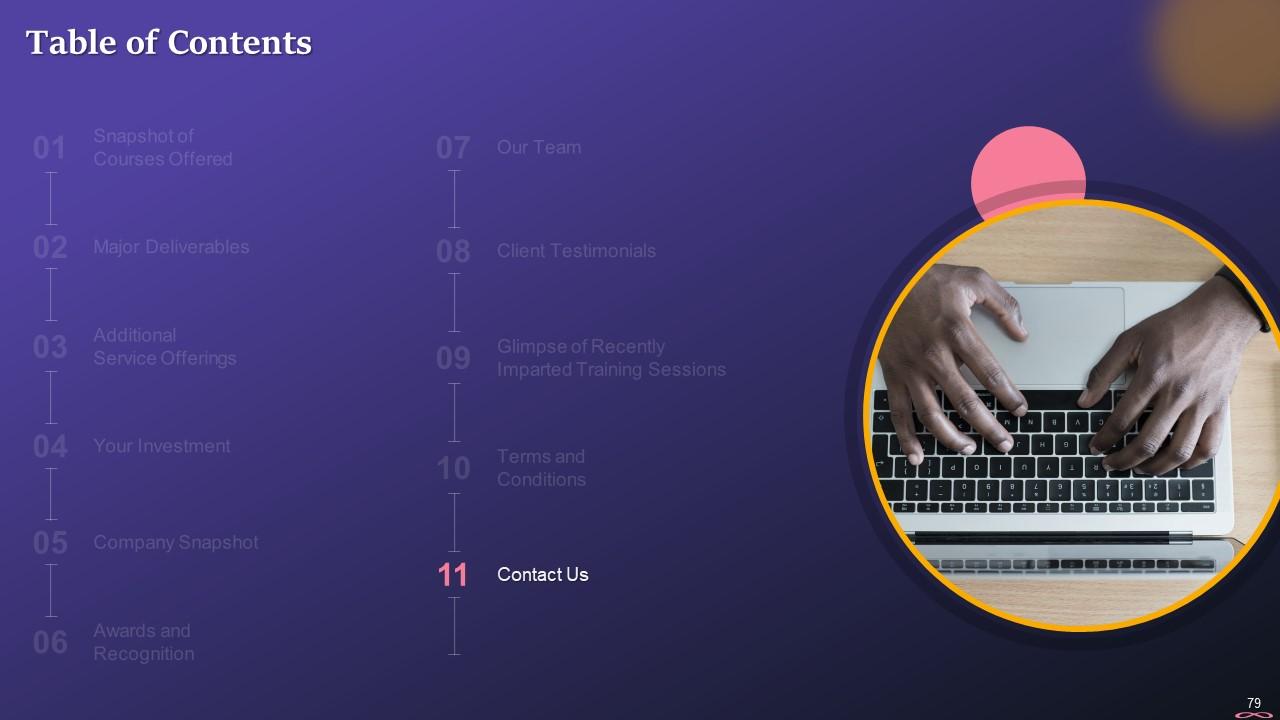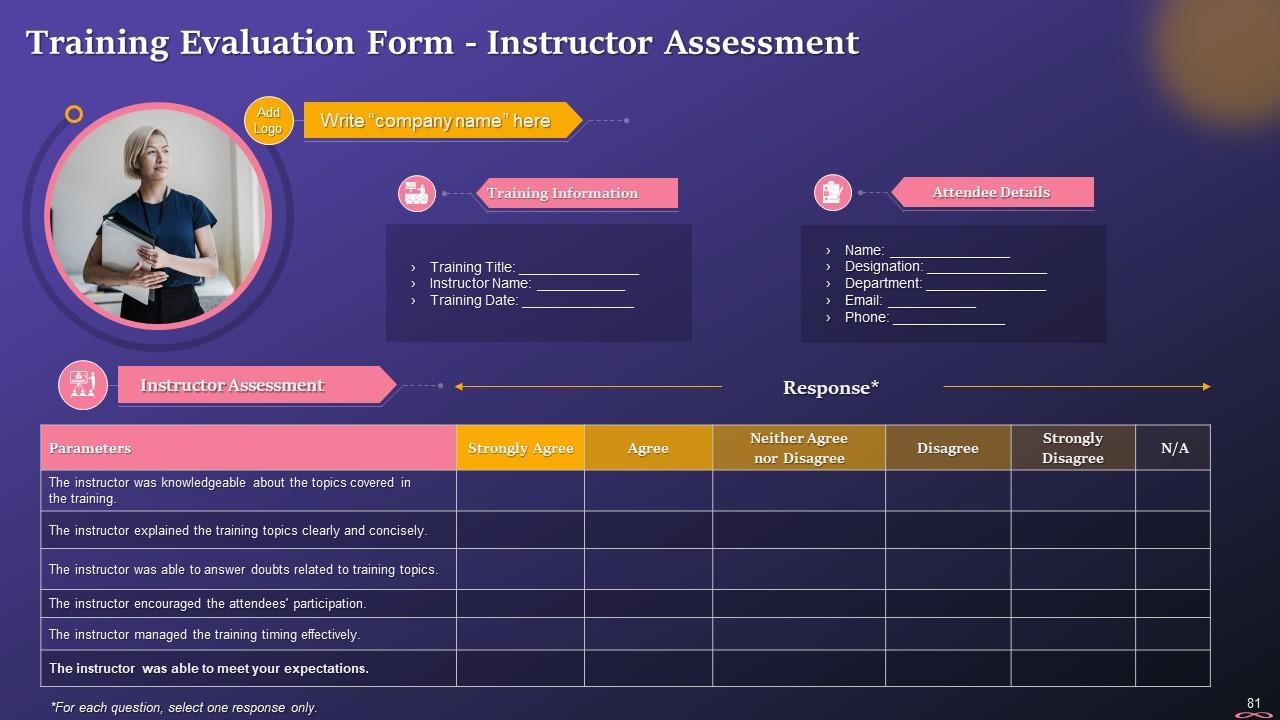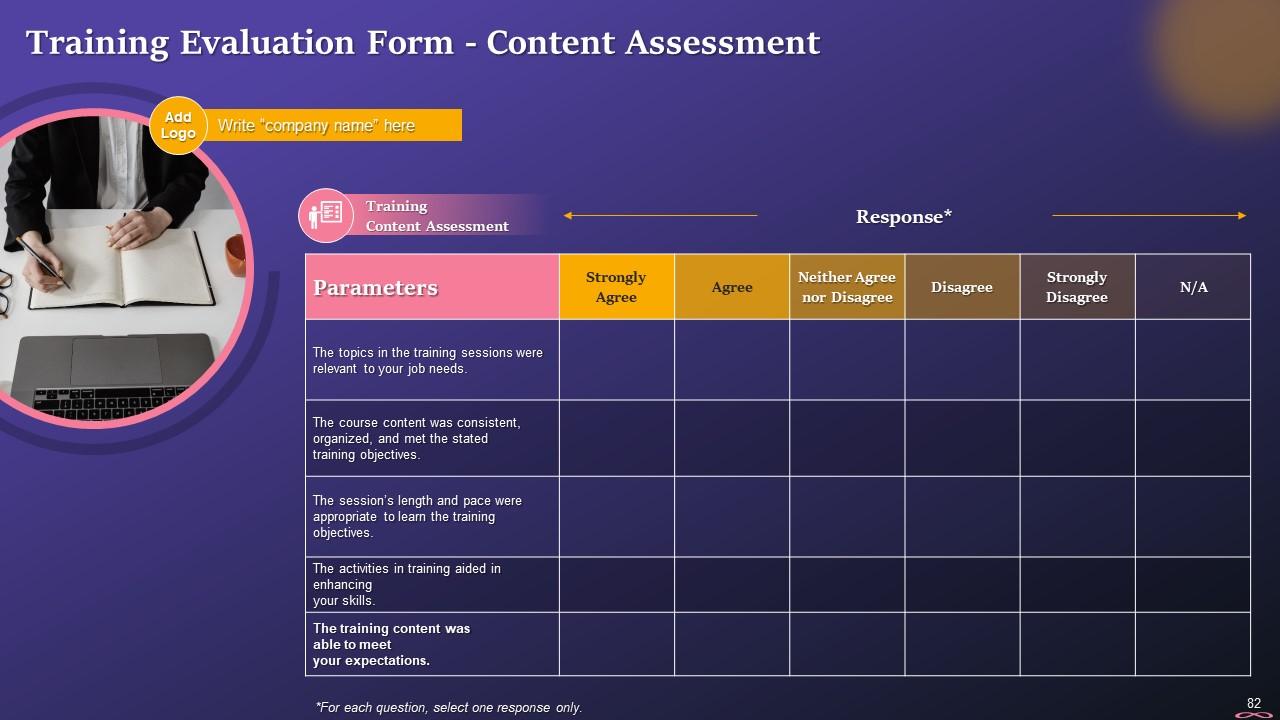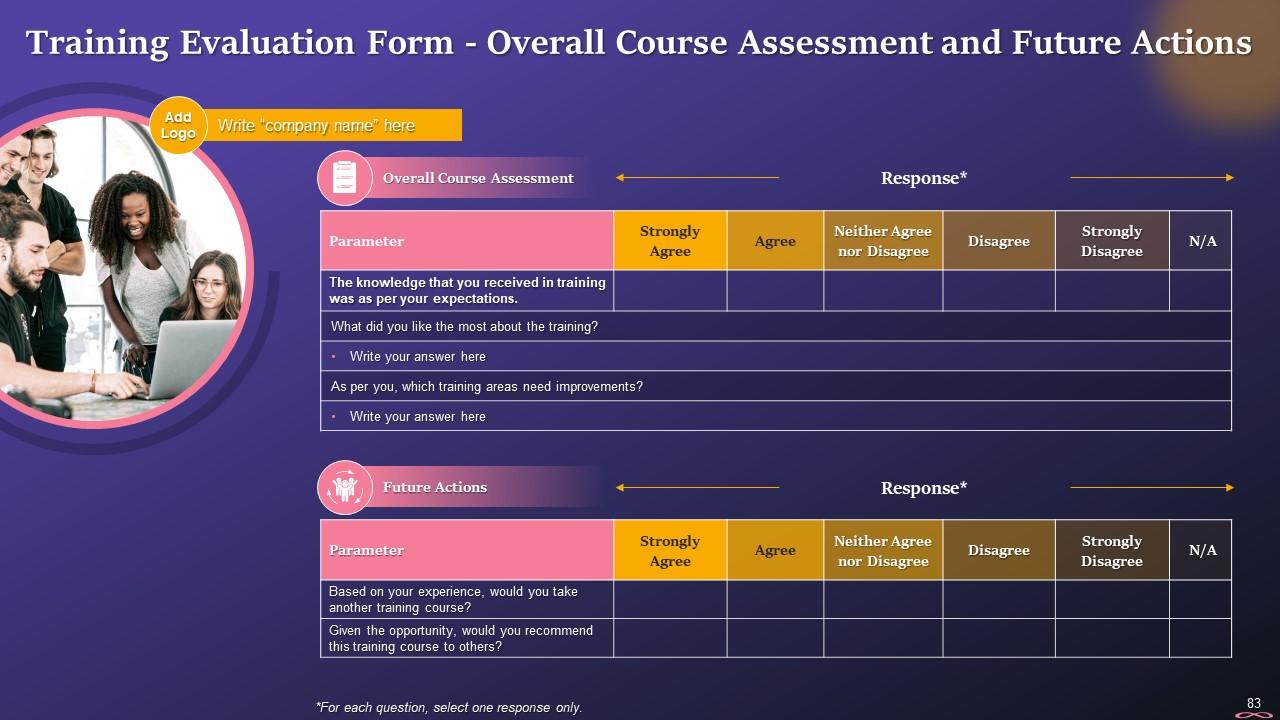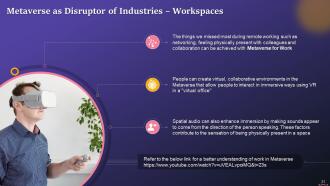Metaverse As Disruptor Of Industries Training Ppt
This training module comprehensively covers how the metaverse has disrupted multiple industries such as Social Media, Gaming, Fashion, Marketing, Architecture, Virtual Shows and Concerts, Art Galleries and Museums, Retail, E-commerce, and Workspaces. It includes key takeaways and discussion questions related to the training topic. The deck also has PPT slides on about us, vision, mission, goal, 30-60-90 days plan, timeline, roadmap, and training completion certificate. It also contains energizer activities to engage the coaching session audience. It also includes a client proposal and assessment form for training evaluation.
This training module comprehensively covers how the metaverse has disrupted multiple industries such as Social Media, Gamin..
- Google Slides is a new FREE Presentation software from Google.
- All our content is 100% compatible with Google Slides.
- Just download our designs, and upload them to Google Slides and they will work automatically.
- Amaze your audience with SlideTeam and Google Slides.
-
Want Changes to This PPT Slide? Check out our Presentation Design Services
- WideScreen Aspect ratio is becoming a very popular format. When you download this product, the downloaded ZIP will contain this product in both standard and widescreen format.
-

- Some older products that we have may only be in standard format, but they can easily be converted to widescreen.
- To do this, please open the SlideTeam product in Powerpoint, and go to
- Design ( On the top bar) -> Page Setup -> and select "On-screen Show (16:9)” in the drop down for "Slides Sized for".
- The slide or theme will change to widescreen, and all graphics will adjust automatically. You can similarly convert our content to any other desired screen aspect ratio.
Compatible With Google Slides

Get This In WideScreen
You must be logged in to download this presentation.
PowerPoint presentation slides
Presenting Training Deck on Metaverse as Disruptor of Industries. This presentation deck contains 83 well researched and uniquely designed slides. These slides are 100 percent made in PowerPoint and are compatible with all screen types and monitors. They also support Google Slides. Premium Customer Support available. Suitable for use by managers, employees and organizations. These slides are easily customizable. You can edit the color, text, icon and font size to suit your requirements.
People who downloaded this PowerPoint presentation also viewed the following :
Content of this Powerpoint Presentation
Slide 2
This slide mentions the topics of the session metaverse as Disruptor of Industries. The industries are social media, gaming, fashion, marketing, architecture, art, retail, e-commerce, etc.
Slide 3
This slide mentions the topics of the session metaverse as Disruptor of Industries. The industries are social media, gaming, fashion, marketing, architecture, art, retail, e-commerce, etc.
Slide 4
This slide depicts information regarding metaverse impacting social media. It emphasizes that today's social media platforms are centralized, rely on traditional distributed database technologies, and are not secure. However, metaverse is a new blockchain-based technology that can dramatically change social media.
Slide 5
This slide illustrates the advantages of using metaverse for social media. The benefits highlighted are metaverse allows users to operate multiple accounts from a single dashboard, discover content, and automate social media post distribution.
Slide 6
This slide showcases information regarding gaming in the metaverse. It emphasizes that metaverse allows users to connect multiple virtual reality games to create a single interoperable environment. It also mentions that the in-game universe is now a three-dimensional virtual reality world that can be viewed in 360 degrees and "touched" with a realistic perception.
Slide 7
This slide depicts the characteristics of gaming in the metaverse. The characteristics are games-as-platforms, social gaming, play to earn, the possibility of portable game assets, and mixed reality experience.
Instructor’s Notes:
The characteristics of gaming in metaverse are:
- Games-as-platforms: The gaming experience will become significantly more adaptable. Users can contribute to the virtual world by creating content, creating sub-games within a game, and treating the gaming environment as a platform-like space for other activities
- Social Gaming: The metaverse is inherently social, distinguishing it from the traditional solitary VR experience. Multi-player gaming will take on a new dimension as players will be able to invite real-world friends, interact with other players, build relationships, etc.
- Play to Earn: This will be an essential aspect of gaming in the metaverse. Players can engage in profitable activities in addition to following linear storytelling and rules. For example, they may be able to sell the assets they have won in the game to other users in exchange for cryptocurrency
- The Possibility of Portable Game Assets: The metaverse's interoperable architecture may enable asset portability. Weapons or avatar enhancements obtained in one game could be transferred to another, and NFT rules would govern ownership continuity
- Mixed Reality Experience: The metaverse uses AR and MR to provide a more natural experience. Gaming in the metaverse could incorporate mixed reality, with users seamlessly transitioning from group text in AR to MR board game to a total VR world
Slide 8
This slide depicts the top picks in the world of metaverse games such as Sandbox, Axie Infinity, Decentraland, Illuvium, and Ultra.
Slide 9
This slide depicts information regarding fashion in the metaverse. It highlights that the metaverse is integrating fashion into people's daily routines. It is predicted that clothing will become more critical in the virtual world.
Slide 10
This slide depicts the how fashion is meeting gaming industry in metaverse. As fashion immerses in the metaverse, it can be broadly divided into two types: Physical and digital, in which clothing can be worn using augmented or virtual realities, and fully digital, in which items are sold directly to an avatar. It also mentions that luxury fashion brands like Gucci, Balenciaga, and Burberry have already made their mark in the world's most popular computer games and the metaverse.
Slide 11
This slide illustrates the marketing concept in metaverse. It emphasizes that metaverse is a new marketing ecosystem that works in a similar fashion as blockchain. It also mentions that no centralized servers or administrators are required because it is decentralized. It is a new marketing strategy that allows you to connect with your target audience.
Slide 12
This slide showcases the advantages of marketing in metaverse. It demonstrates that marketing and advertising in metaverse are at a nascent stage, with currently very low campaign costs. It also mentions that as NFTs gain popularity, demand for digital collectibles (like virtual sneakers) is expected to rise, making metaverse marketing profitable.
Slide 13
This slide depicts metaverse marketing strategies. The strategies highlighted are integrate yourself into the platform natively, parallel real-life marketing in a virtual setting, offer virtual goods to digital avatars, create your virtual location, create immersive environments, and provide digital collectibles.
Instructor’s Notes:
The top metaverse marketing techniques are:
- Integrate yourself into the platform natively: Advertising is, by nature, something that interrupts. A five-second ad at the start of a YouTube video can stop people in their tracks, but it can also become annoying. Inserting naturally into the platform, on the other hand, allows a person to engage with users without interfering with their gaming experience
- Parallel real-life marketing in a virtual setting: Transitioning into the metaverse does not require you to do everything differently. An excellent start is by replicating what you provide in real life in the parallel virtual world. It is not only a natural way to enter the metaverse, but it is also a genuine way for users to notice your brand
- Offer virtual goods to digital avatars: In the metaverse, where avatars represent people, online identities are critical. When creating virtual avatars, people place a high value on customization. People in the 3D environment, like in real life, spend a lot of money on self-expression. As a result, the direct-to-avatar (D2A) economy is gaining traction. It enables businesses to sell virtual retail products directly to avatars. Naturally, Fashion brands are seizing this opportunity
- Create your virtual venue: Going digital should not prevent one from opening a store. A virtual 3D store, museum, or island can help establish a presence in the metaverse and form a strong emotional bond with customers. Tours, virtual try-on or try-outs, and interactive 3D product exhibits are all options
- Create immersive environments: The most important driver of customer engagement is experiential marketing. According to studies, brands that focus on creating experiences gain 25% more brand loyalty than those not. Providing an immersive experience forces audiences to step outside of their comfort zone, which can impact their perception of your brand and help you form a deeper connection with them
- Provide digital collectibles: Humans have an innate desire to collect, which will not change in the metaverse. Collectibles in these virtual spaces make use of digital assets known as NFTs. This means that the original owner of a collectible, such as digital art, music, or clothing, is encrypted and unchangeable unless the owner sells it to another person
Slide 14
This slide illustrates how metaverse is disrupting architecture. It demonstrates how architects help to bring imaginative projects to life in metaverse. In metaverse, individuals need places to go, so architects and designers must create or improve these spaces. Meta architects will be solely concerned with form, geometry, and visuals. It also emphasizes how future generations could use metaverse to preserve buildings in this digital reality.
Slide 15
This slide mentions the topics of the session metaverse as Disruptor of Industries. The industries are social media, gaming, fashion, marketing, architecture, art, retail, e-commerce, etc.
Slide 16
This slide depicts information regarding virtual shows and concerts in metaverse. It emphasizes that with online social events becoming more mainstream, metaverse will go on to bridge geographical divides in an even more tangible manner. It also highlights that in metaverse, virtual attendees will interact with brands and keynote speakers in 3D or holographic form, rather than just talking to them on social media.
Slide 17
This slide showcases information regarding art and museums in the metaverse. It highlights that an NFT represents a one-of-a-kind digital work of art whose authenticity can be verified using blockchain technology. NFTs are disrupting the art world by changing how art is traded. Digital artists can sell directly to collectors via platforms such as OpenSea and Foundation, bypassing dealers and galleries.
Slide 18
This slide depicts information about metaverse in the retail industry. It emphasizes that metaverse will allow online users to shop and interact with products in the virtual world using a digital avatar. It also mentions that metaverse will allow online users to use a digital avatar to shop and interact with products in the virtual world.
Slide 19
This slide illustrates the use cases of embracing retail in metaverse. Shopping in metaverse may be a novel concept for many users, but it is already being adopted by a diverse range of brands and businesses. Aside from avatar shopping, the following are some of the most popular use cases are: virtual reality, integrated branding, selling NFTs, Augmented Reality (AR), and products for digital avatars.
Slide 20
This slide depicts information about e-commerce in metaverse. It demonstrates how metaverse will usher in a new era of virtual reality in the e-commerce sector. Indeed, online buyers will use their personalized virtual avatar to interact with products of interest in real-time. It also states that if an e-commerce company uses metaverse to create a digital storefront, buyers will enter, explore, and inspect the products they wish to purchase.
Slide 21
This slide depicts information about metaverse workspaces. It demonstrates that the things missed out during remote working, such as networking and feeling physically present with colleagues, can be primarily achieved with metaverse for work. In the metaverse, people can create virtual, collaborative environments that allow people to interact in immersive ways using VR in a "virtual office."
Slide 22
This slide illustrates the advantages of Work in metaverse. The advantages are major improvements to traditional remote work, 3D world for problem-solving, infinite space, and freedom from hardware.
Instructor’s Notes:
The advantages of work in metaverse are:
- Major Improvements to Traditional Remote Work: A major complaint about remote work has been the lack of real interaction. The metaverse offers an expansive virtual workplace where employee images or avatars can interact with and experience the workplace in a manner more reminiscent of the traditional environment
- 3D World for Problem-solving: Many business projects and issues are best addressed using visual tools and images, but this has not always been possible due to technological limitations. Using AI and digital twin technology, a new 3D world will allow almost anything to be modeled, examined, and tested
- Infinite Space: Almost every organization will require additional office space at some point. The metaverse promises infinite space, empowering developers to add extensions to existing space and make them fully interoperable and collaborative
- Freedom from Hardware: In terms of efficiency, metaverse promises access to digital whiteboards, workstations, and conferencing equipment at a fraction of the cost of in the real world that we inhabit
Slide 23
This slide illustrates the key takeaways for the session industries that metaverse has disrupted
Slide 25
This slide mentions questions for discussion on the topic metaverse as disruptor of industries.
Slide 37 to 52
These slides depict energizer activities to engage the audience of the training session.
Slide 53 to 80
These slides contain a training proposal covering what the company providing corporate training can accomplish for the client.
Slide 81 to 83
These slides include a training evaluation form for instructor, content and course assessment.
Metaverse As Disruptor Of Industries Training Ppt with all 88 slides:
Use our Metaverse As Disruptor Of Industries Training Ppt to effectively help you save your valuable time. They are readymade to fit into any presentation structure.
-
I was really impressed with the presentation I created with their templates. I’ll be using their services moving forward.
-
“Detailed and great to save your time.”


